

EMI Cassette Tapes
Gold Top Inlay Series
#12. Let It Be (TC-PCS 7096)
(Update: 12th November 2025)




 |
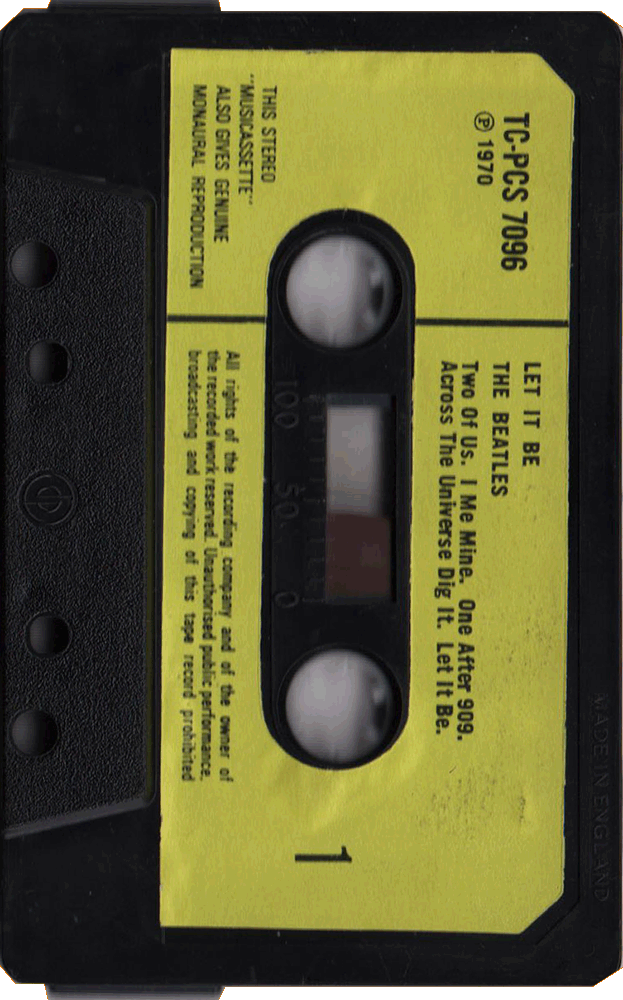 |
|
|
| Parlophone Gold
Top Inlay and Tape |
|||
|
TITLE
|
LET IT BE |
|||
| CATALOG NUMBER | TC-PCS 7096 / 1E 262 o 04482 |
|||
|
RELEASE DATE
|
1974? / 4th Issue? | |||
| TRACK LISTING | SIDE 1 | SIDE 2 | ||
| Two Of Us [A1] |
Maggie Mae [A7] |
|||
| I Me Mine [A4] |
Dig A Pony [A2] |
|||
| One After 909 [B2] |
The Long And Winding Road [B3] |
|||
| Across The Universe [A3] |
I Got A Feeling [B1] (inlay) |
|||
| Dig It [A5] |
For You Blue [B4] |
|||
| Let It Be [A6] | Get Back [B5] | |||
| CASSETTE CASE AND TAPE |
CASE FRONT | CASE BACK | SIDE 1 --> Click! | SIDE 2 --> Click! |
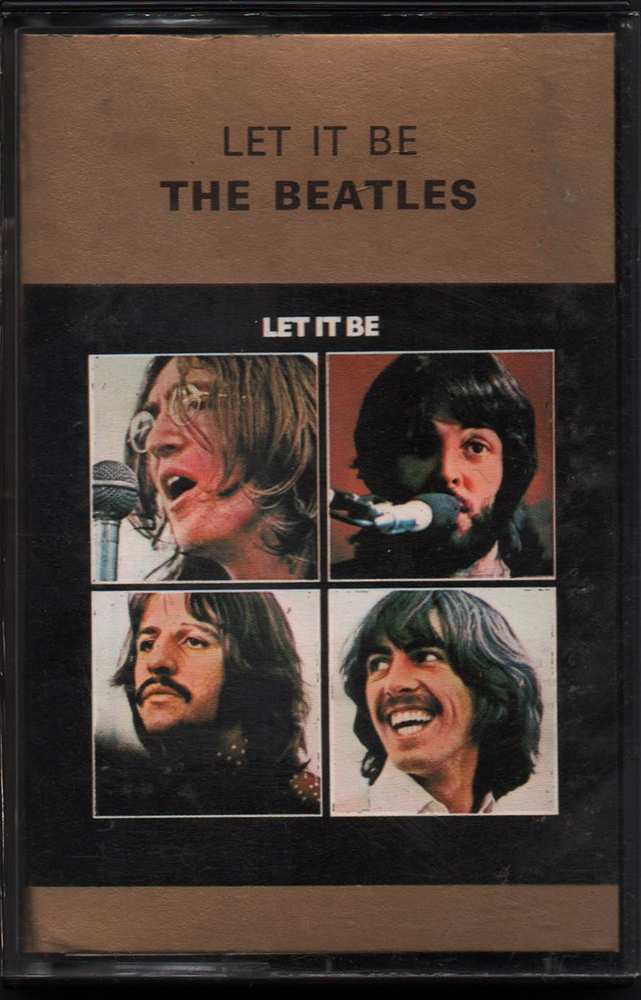 |
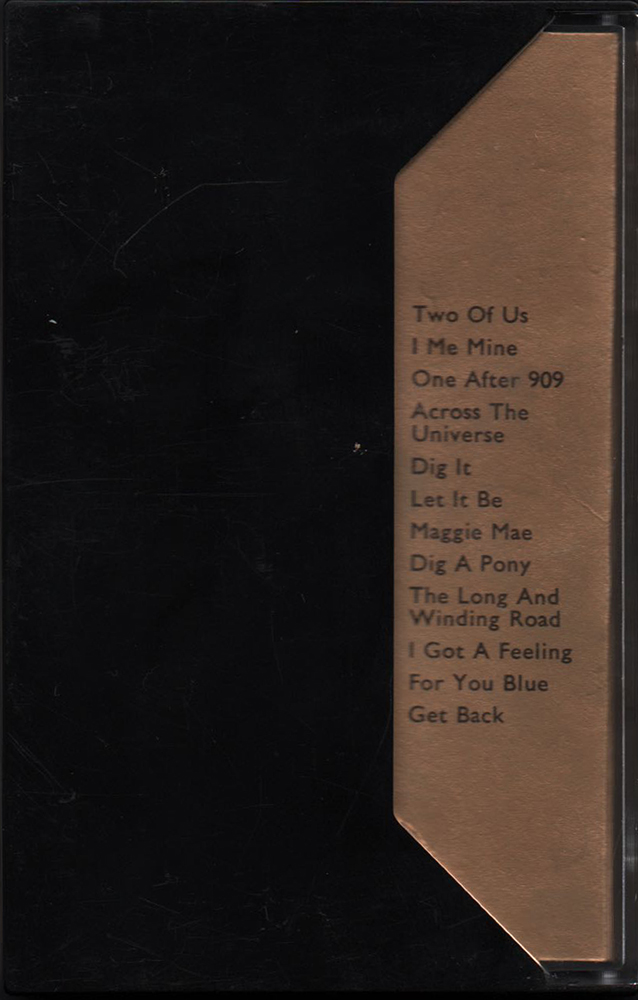 |
 |
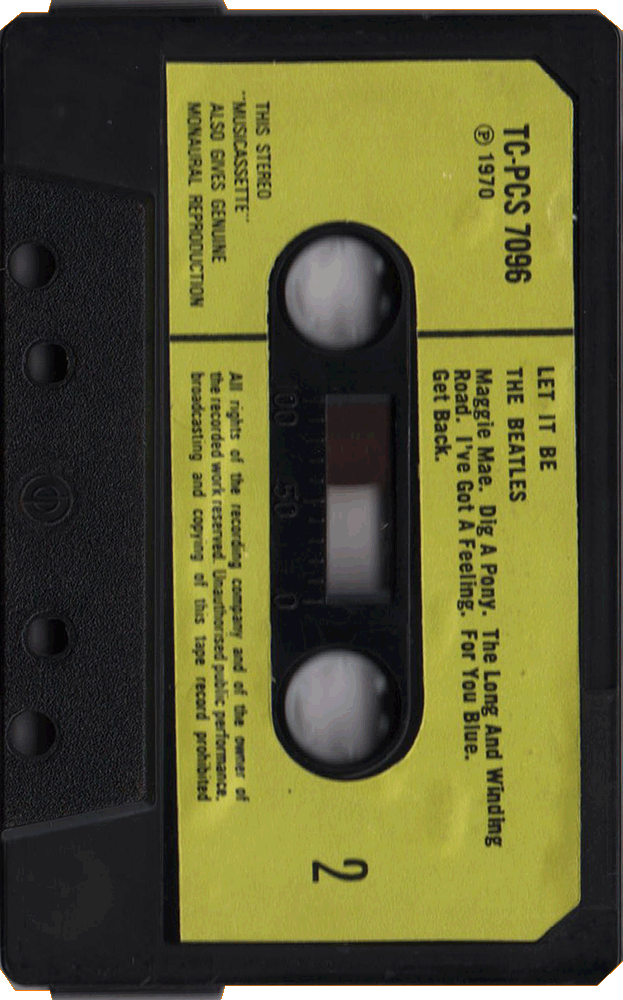 |
|
| The cassette cases ("Norelco" cases)
were clear plastic at the front and around the spine area,
and black plastic at the rear. |
This UK issue has Lemon
yellow paper label on Black shell. |
|||
| INLAY |
INLAY: FRONT | INLAY: INSIDE |
||
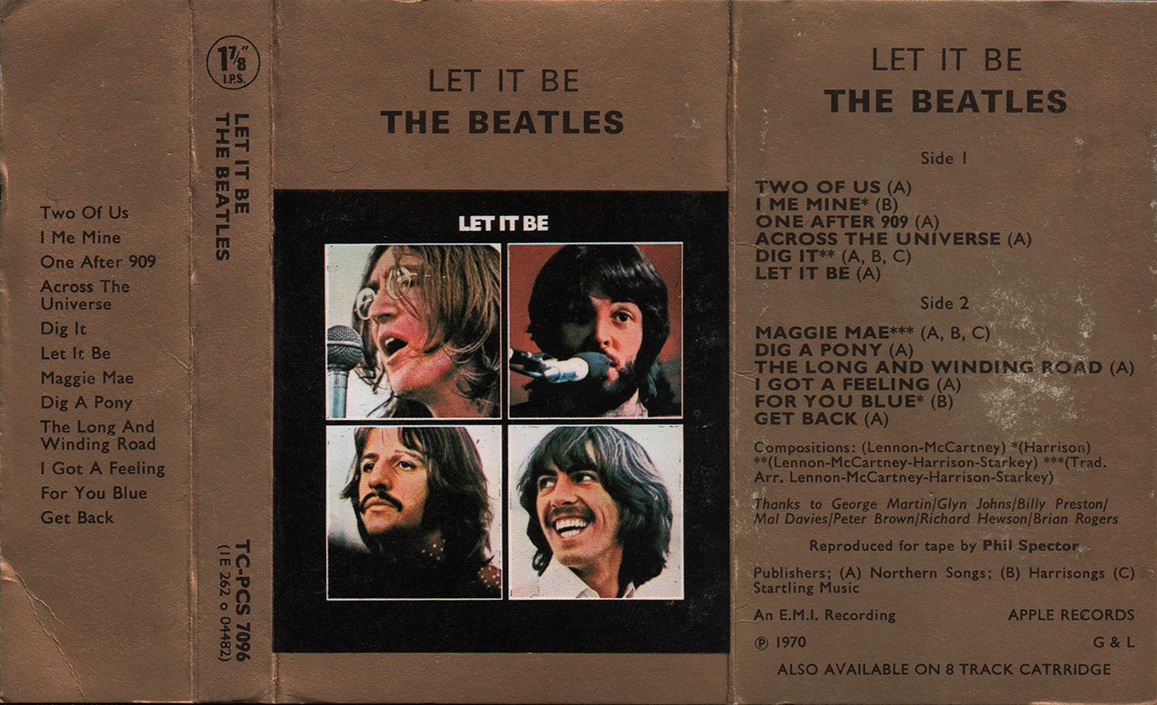 |
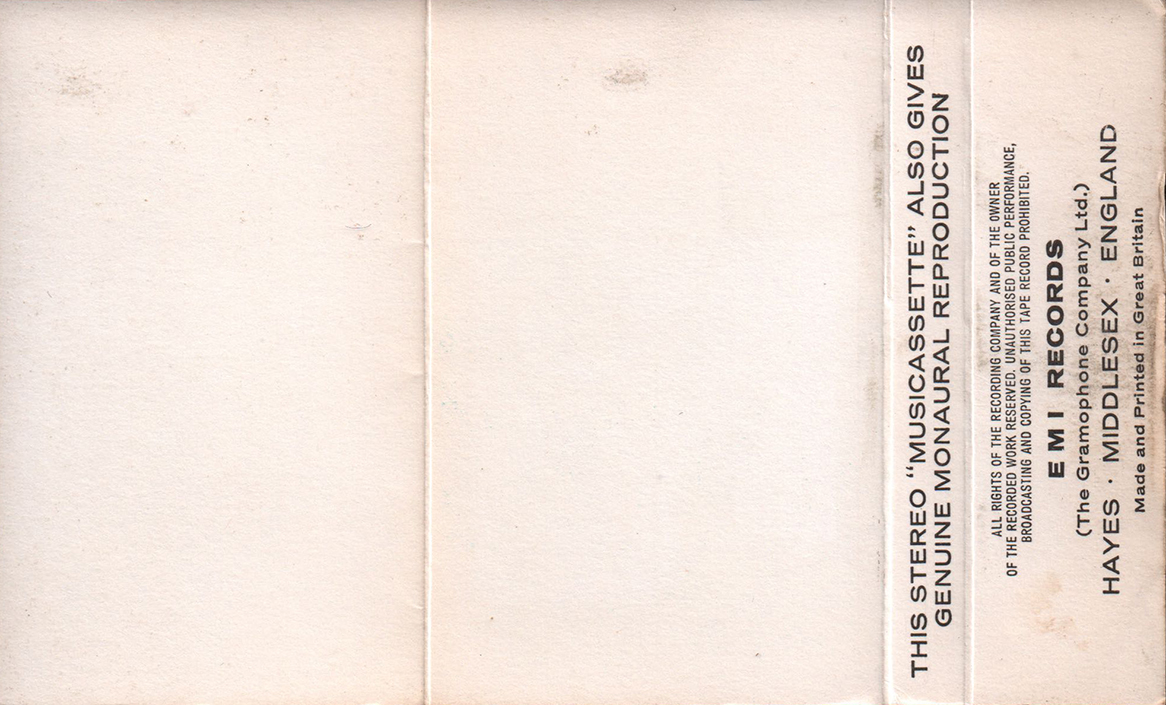 |
|||
| EMI metallic effect "Gold Top" cassette
inlay. ”Gold Top inlay" are believed to have been introduced in January 1972. |
||||
| INLAY: FRONT CLOSE UP | ||||
 |
 |
 |
EMI metallic
effect "Gold Top" cassette inlay. The circular 1 7/8 " I.P.S. mark was printed at the spine. |
|
| INLAY: FRONT CLOSE UP | ||||
 |
 |
|||
| EMI originally issued the Beatles
UK albums on cassette tape with re-arranged running orders,
the excuse being the need to have two sides of equal length
to avoid the problem of listeners stopping the tape at the
end of one side and turning over to start mid-way through
the opening track on the reverse. Inlay incorrectly spells track 4 on side-2 as "I got a feeling" |
||||
| INLAY: INSIDE CLOSE UP | ||||
 |
Catalog number "TC-PCS 7096" and the EMI country code (*1) were printed on the inlay. |  |
Printer company's name (removed relrease date) "G&L" was printed at the bottom of the inlay. | |
| INLAY: INSIDE CLOSE UP | ||||
 |
"E.M.I.
Records (The Gramophone Company Ltd.)" credit was printed at
the bottom of the inside of the inlay. |
|||
| LABEL CLOSE UP | ||||
 |
 |
 |
 |
|
| The cassettes
was issued NO Parlophone logo. "IE" catalogue number (*) in addition to the ordinary "TC-PCS 7096" EMI catalogue number, but not printed on the label. |
Containing content as a prerecorded cassette is called "Musicassette" | The "DP(**)" logo was not
moulded into cassette shells, especially during the early to
mid 1970s. |
||
| LABEL CLOSE UP | ||||
| SIDE
1 |
SIDE 2 |
EMI
originally issued the Beatles UK albums on cassette tape
with re-arranged running orders. |
||
 |
 |
|||
| LABEL CLOSE UP | ||||
 |
"Made
in England" was embossed the shell on
both sides. |
|||
| OTHER ITEM | ||||
| - |
||||
| LABEL | Lemon Yellow Paper Label (without
Parlophone or Apple logo) |
|||
| MIX | STEREO |
|||
| RECORD COMPANY'S NAME | EMI Records (The Gramophone Company Ltd.) / An E.M.I. Recording | |||
| CENTRAL REMARK "SOLD IN U.K." |
- | |||
| RECORDING PUBLISHED CREDIT | (P) 1970 |
|||
| INLAY FORM | Metallic effect gold inlay (Foldover) |
|||
| SHELL | Black Shell / embossed
"MADE IN ENGLAND" and "dp" logo mark |
|||
| CASSETTE CASE |
"Norelco"
cases: clear plastic at the front and around the spine area,
and black plastic at the rear. |
|||
| PRINTER CREDIT | Made and Printed in Great Britain / G
& L (Garrod & Lofthouse) |
|||
| COVER DESIGN/ PHOTO/ NOTES | Design: by John Kosh Photographs: Ethan Russell |
|||
| PRODUCER | Reproduced for tape by Phil Spector | |||
| COMMENTS | Lemon yellow paper label on
Black shell cassette, with its original inlay and
case. The U.K. cassette release of this album was early 1974. The album was released at the start of the winter of strikes, power cuts and the three day week which caused serious disruption to production at EMI's Hayes plant in 1973. Several titles released in this period were initially issued in unusual blue tape shells probably because of supply chain issues. EMI "Gold Top" cassette inlay. “Gold Top inlay” are believed to have been introduced in January 1972. The G&L notation on the inside inlay indicates the printer's initials (Ernest J Day, Garrod & Lofthouse, or Data Packaging). The EMI UK catalog no. (TC-PCS-7096) was on the spine. The cassette cases ("Norelco" cases) were clear plastic at the front and around the spine area, and black plastic at the rear. The "DP(**)" logo can often be found moulded into cassette shells, especially during the early to mid 1970s. "Made in England" was embossed the shell on both sides. (*1) EMI country code: 1E 262 o 04482 The EMI country codes (introduced on 1 June, 1969): In most cases the EMI Codes are the first two letters of the record's catalog#. These EMI Country Codes were used to indicate the country in which the record was pressed. Note this doesn't necessarily means the record was also released in that country (from Discog). OC / 0C / 1E= UK (**)Data Packaging Corporation: (who also traded as Hellerman Data Packaging Ltd) supplied cassette and 8 track shells, tape and other components to the music industry. The "DP" logo can often be found moulded into cassette shells, especially during the early to mid 1970s. |
|||
|
TITLE
|
LET IT BE |
|||
| CATALOG NUMBER | TC-PCS 7096 / 1E 262 o 04482 |
|||
|
RELEASE DATE
|
1974? / 4th Issue? | |||
| TRACK LISTING | SIDE 1 | SIDE 2 | ||
| Two Of Us [A1] |
Maggie Mae [A7] |
|||
| I Me Mine [A4] |
Dig A Pony [A2] |
|||
| One After 909 [B2] |
The Long And Winding Road [B3] |
|||
| Across The Universe [A3] |
I Got A Feeling [B1] (inlay) |
|||
| Dig It [A5] |
For You Blue [B4] |
|||
| Let It Be [A6] | Get Back [B5] | |||
| CASSETTE CASE AND TAPE |
CASE FRONT | CASE BACK | SIDE 1 --> Click! | SIDE 2 --> Click! |
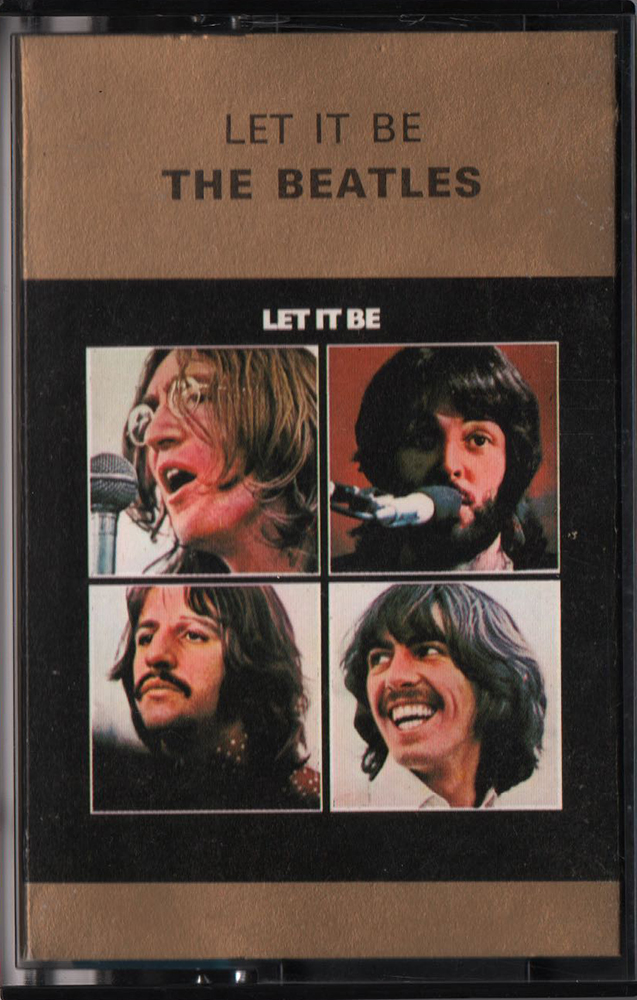 |
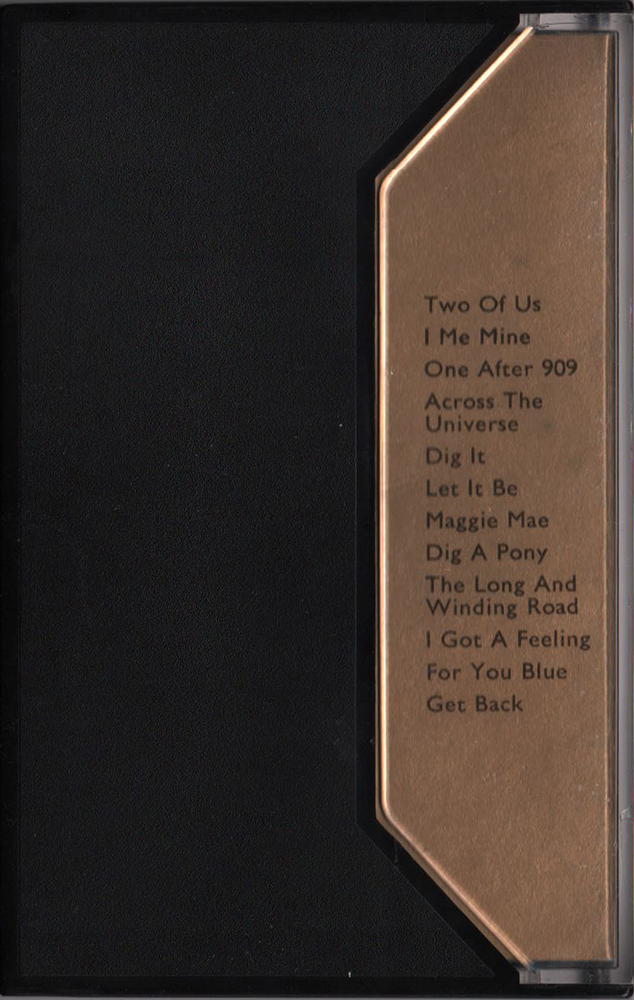 |
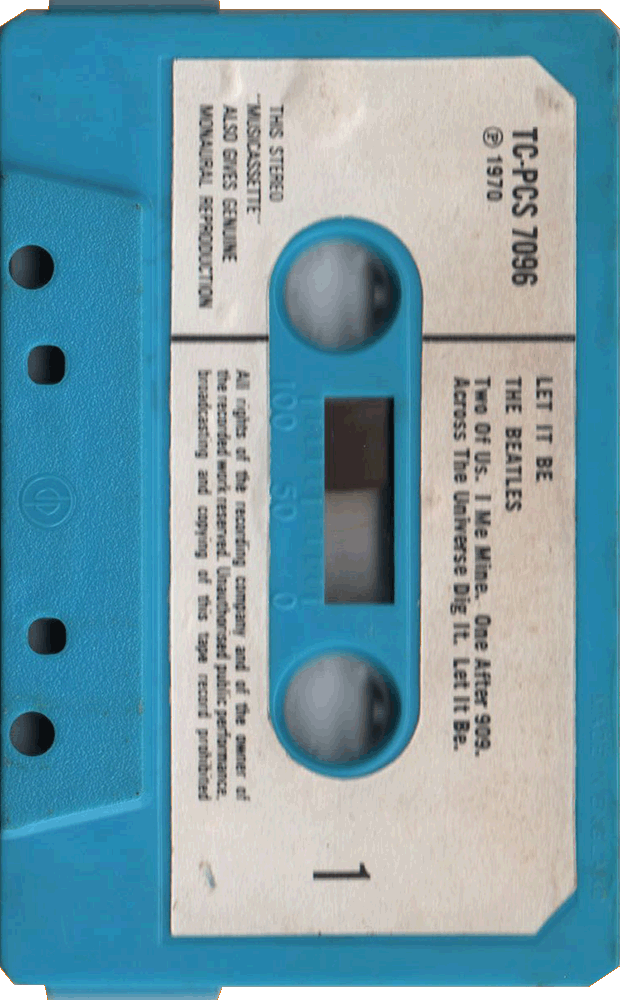 |
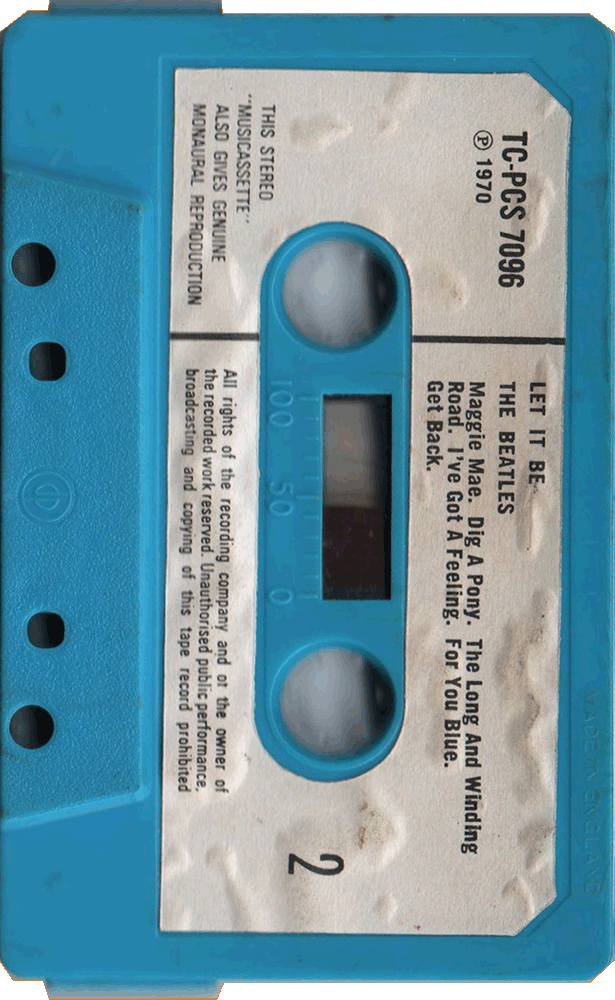 |
|
| The cassette cases ("Norelco" cases)
were clear plastic at the front and around the spine area,
and black plastic at the rear. |
This UK issue has White
paper
label on Blue shell. |
|||
| INLAY |
INLAY: FRONT | INLAY: INSIDE |
||
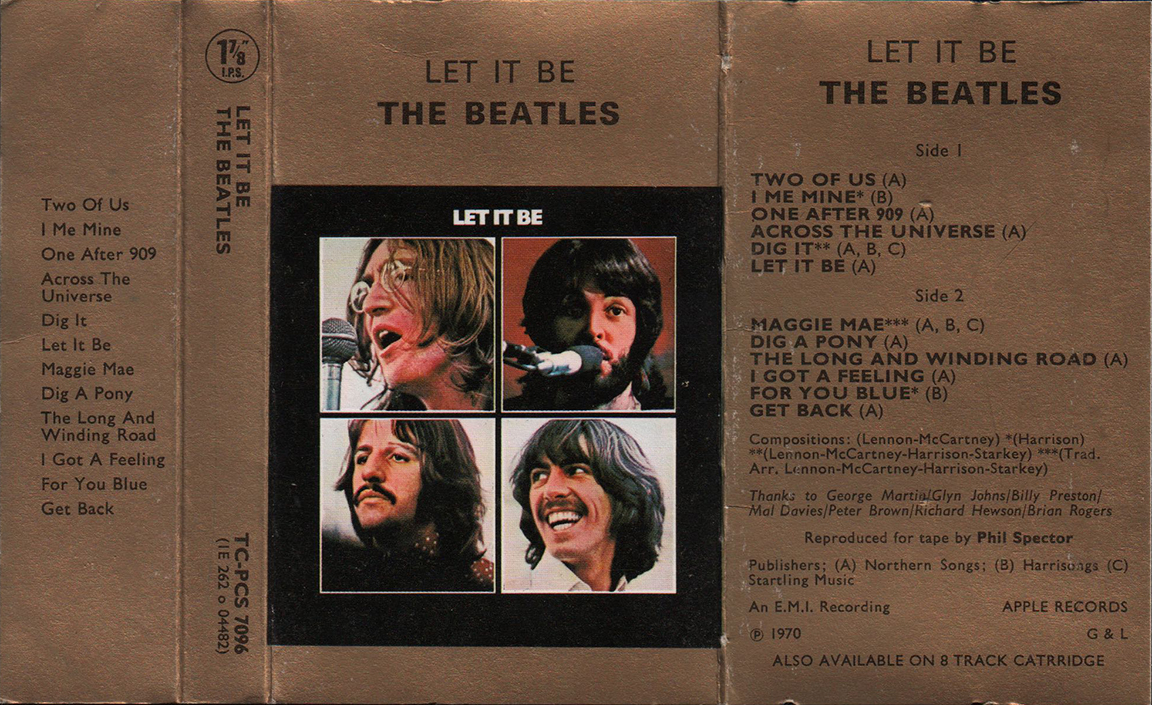 |
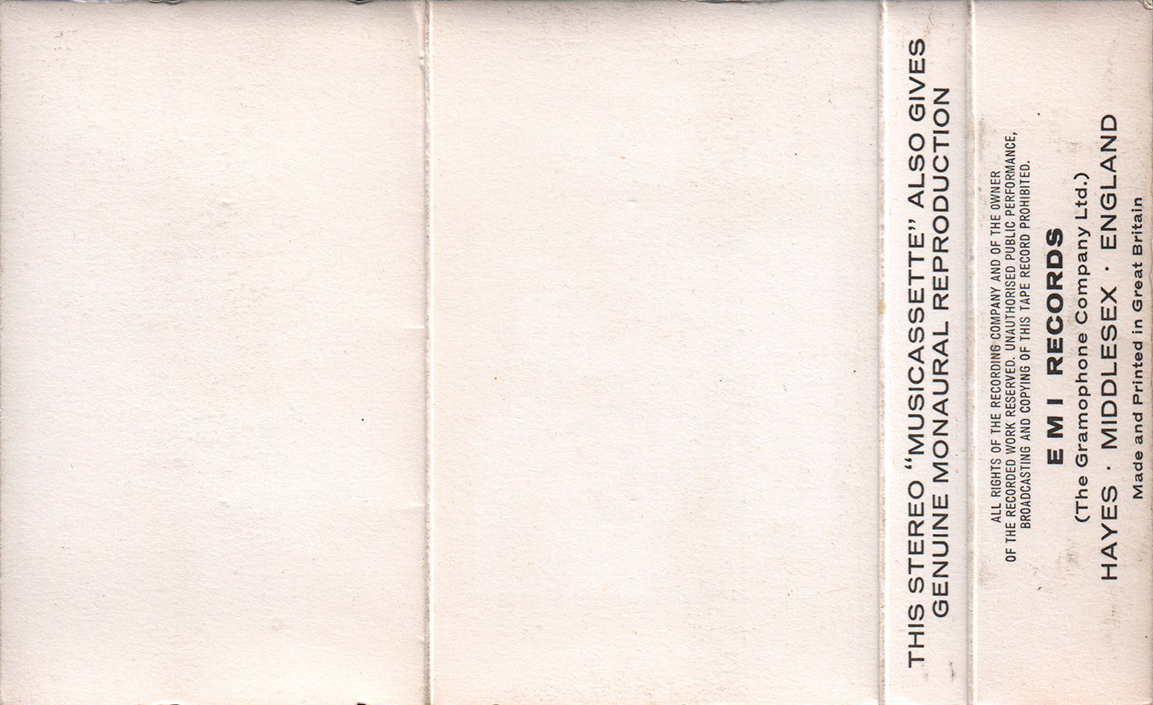 |
|||
| EMI metallic effect "Gold Top" cassette
inlay. ”Gold Top inlay" are believed to have been introduced in January 1972. |
||||
| INLAY: FRONT CLOSE UP | ||||
 |
The circular 1 7/8 " I.P.S. mark was
printed at the spine. As the standard tape speed for a compact cassette is 1 ⅞ ips (1.875 inches per second). |
 |
EMI metallic
effect "Gold Top" cassette inlay. |
|
| INLAY: FRONT CLOSE UP | ||||
 |
 |
|||
| EMI originally issued the Beatles
UK albums on cassette tape with re-arranged running orders,
the excuse being the need to have two sides of equal length
to avoid the problem of listeners stopping the tape at the
end of one side and turning over to start mid-way through
the opening track on the reverse. Inlay incorrectly spells track 4 on side-2 as "I got a feeling" |
||||
| INLAY: INSIDE CLOSE UP | ||||
 |
Catalog number "TC-PCS 7096" and the EMI country code (*1) were printed on the inlay. |  |
Printer company's name (removed relrease date) "G&L" was printed at the bottom of the inlay. | |
| INLAY: INSIDE CLOSE UP | ||||
 |
"E.M.I.
Records (The Gramophone Company Ltd.)" credit was printed at
the bottom of the inside of the inlay. |
|||
| LABEL CLOSE UP | ||||
 |
 |
 |
 |
|
| The cassettes
was issued NO Parlophone logo. "IE" catalogue number (*) in addition to the ordinary "TC-PCS 7096" EMI catalogue number, but not printed on the label. |
Containing content as a prerecorded cassette is called "Musicassette" | The "DP(**)" logo was not
moulded into cassette shells, especially during the early to
mid 1970s. |
||
| LABEL CLOSE UP | ||||
| SIDE
1 |
SIDE 2 |
EMI
originally
issued the Beatles UK albums on cassette tape with
re-arranged running orders. |
||
 |
 |
|||
| LABEL CLOSE UP | ||||
 |
"Made
in
England" was embossed the shell on both
sides. |
|||
| OTHER ITEM | ||||
| - |
||||
| LABEL | White Paper Label without
Parlophone logo |
|||
| MIX | STEREO |
|||
| RECORD COMPANY'S NAME | EMI Records (The Gramophone Company Ltd.) / An E.M.I. Recording | |||
| CENTRAL REMARK "SOLD IN U.K." |
- | |||
| RECORDING PUBLISHED CREDIT | (P) 1970 |
|||
| INLAY FORM | Metallic effect gold inlay (Foldover) |
|||
| SHELL | Blue Shell / embossed
"MADE IN ENGLAND" and "dp" logo mark |
|||
| CASSETTE CASE |
"Norelco"
cases:
clear plastic at the front and around the spine area, and
black plastic at the rear. |
|||
| PRINTER CREDIT | Made and Printed in Great Britain / G
& L (Garrod & Lofthouse) |
|||
| COVER DESIGN/ PHOTO/ NOTES | Design: by John Kosh Photographs: Ethan Russell |
|||
| PRODUCER | Reproduced for tape by Phil Spector | |||
| COMMENTS | White paper label without
Parlophone logo on Blue shell cassette, with
its original inlay and case. The U.K. cassette release of this album was early 1974. The album was released at the start of the winter of strikes, power cuts and the three day week which caused serious disruption to production at EMI's Hayes plant in 1973. Several titles released in this period were initially issued in unusual blue tape shells probably because of supply chain issues. EMI "Gold Top" cassette inlay. “Gold Top inlay” are believed to have been introduced in January 1972. The G&L notation on the inside inlay indicates the printer's initials (Ernest J Day, Garrod & Lofthouse, or Data Packaging). The EMI UK catalog no. (TC-PCS-7096) was on the spine. The cassette cases ("Norelco" cases) were clear plastic at the front and around the spine area, and black plastic at the rear. The "DP(**)" logo can often be found moulded into cassette shells, especially during the early to mid 1970s. "Made in England" was embossed the shell on both sides. (*1) EMI country code: 1E 262 o 04482 The EMI country codes (introduced on 1 June, 1969): In most cases the EMI Codes are the first two letters of the record's catalog#. These EMI Country Codes were used to indicate the country in which the record was pressed. Note this doesn't necessarily means the record was also released in that country (from Discog). OC / 0C / 1E= UK (**)Data Packaging Corporation: (who also traded as Hellerman Data Packaging Ltd) supplied cassette and 8 track shells, tape and other components to the music industry. The "DP" logo can often be found moulded into cassette shells, especially during the early to mid 1970s. |
|||
|
TITLE
|
LET IT BE |
|||
| CATALOG NUMBER | TC-PCS 7096 / 1E 262 o 04482 |
|||
|
RELEASE DATE
|
1975? / 5th Issue? | |||
| TRACK LISTING | SIDE 1 | SIDE 2 | ||
| Two Of Us [A1] |
Maggie Mae [A7] |
|||
| I Me Mine [A4] |
Dig A Pony [A2] |
|||
| One After 909 [B2] |
The Long And Winding Road [B3] |
|||
| Across The Universe [A3] |
I Got A Feeling [B1] (inlay) |
|||
| Dig It [A5] |
For You Blue [B4] |
|||
| Let It Be [A6] | Get Back [B5] | |||
| CASSETTE CASE AND TAPE |
CASE FRONT | CASE BACK | SIDE 1 --> Click! | SIDE 2 --> Click! |
 |
 |
 |
 |
|
| The cassette cases ("Norelco" cases)
were clear plastic at the front and around the spine area,
and black plastic at the rear. |
This UK issue has White
paper
label on light grey shell. |
|||
| INLAY |
INLAY: FRONT | INLAY: INSIDE |
||
 |
 |
|||
| EMI metallic effect "Gold Top" cassette
inlay. ”Gold Top inlay" are believed to have been introduced in January 1972. |
||||
| INLAY: FRONT CLOSE UP | ||||
 |
The circular 1 7/8 " I.P.S. mark was
printed at the spine. As the standard tape speed for a compact cassette is 1 ⅞ ips (1.875 inches per second). |
 |
EMI metallic
effect "Gold Top" cassette inlay. |
|
| INLAY: FRONT CLOSE UP | ||||
 |
 |
|||
| EMI originally issued the Beatles
UK albums on cassette tape with re-arranged running orders,
the excuse being the need to have two sides of equal length
to avoid the problem of listeners stopping the tape at the
end of one side and turning over to start mid-way through
the opening track on the reverse. Inlay incorrectly spells track 4 on side-2 as "I got a feeling" |
||||
| INLAY: INSIDE CLOSE UP | ||||
 |
Catalog number "TC-PCS 7096" and the EMI country code (*1) were printed on the inlay. |  |
Printer company's name (removed relrease date) "G&L" was printed at the bottom of the inlay. | |
| INLAY: INSIDE CLOSE UP | ||||
 |
"E.M.I.
Records (The Gramophone Company Ltd.)" credit was printed at
the bottom of the inside of the inlay. |
|||
| LABEL CLOSE UP | ||||
 |
 |
 |
 |
|
| The cassettes
was issued NO Parlophone logo. "IE" catalogue number (*) in addition to the ordinary "TC-PCS 7096" EMI catalogue number, but not printed on the label. |
Containing content as a prerecorded cassette is called "Musicassette" | NO mark was moulded into cassette shells. | ||
| LABEL CLOSE UP | ||||
| SIDE
1 |
SIDE 2 |
EMI
originally
issued the Beatles UK albums on cassette tape with
re-arranged running orders. |
||
 |
 |
|||
| LABEL CLOSE UP | ||||
 |
"Made
in
England / Made in U.S.A" was not embossed the shell. |
|||
| OTHER ITEM | ||||
| - |
||||
| LABEL | White Paper Label without
Parlophone logo |
|||
| MIX | STEREO |
|||
| RECORD COMPANY'S NAME | EMI Records (The Gramophone Company Ltd.) / An E.M.I. Recording | |||
| CENTRAL REMARK "SOLD IN U.K." |
- | |||
| RECORDING PUBLISHED CREDIT | (P) 1970 |
|||
| INLAY FORM | Metallic effect gold inlay (Foldover) |
|||
| SHELL | Light Grey Shell |
|||
| CASSETTE CASE |
"Norelco"
cases:
clear plastic at the front and around the spine area, and
black plastic at the rear. |
|||
| PRINTER CREDIT | Made and Printed in Great Britain / G
& L (Garrod & Lofthouse) |
|||
| COVER DESIGN/ PHOTO/ NOTES | Design: by John Kosh Photographs: Ethan Russell |
|||
| PRODUCER | Reproduced for tape by Phil Spector | |||
| COMMENTS | White paper label without
Parlophone logo on light grey shell cassette, with its
original inlay and case. EMI "Gold Top" cassette inlay. “Gold Top inlay” are believed to have been introduced in January 1972. The G&L notation on the inside inlay indicates the printer's initials (Ernest J Day, Garrod & Lofthouse, or Data Packaging). The EMI UK catalog no. (TC-PCS-7096) was on the spine. The cassette cases ("Norelco" cases) were clear plastic at the front and around the spine area, and black plastic at the rear. (*1) EMI country code: 1E 262 o 04482 The EMI country codes (introduced on 1 June, 1969): In most cases the EMI Codes are the first two letters of the record's catalog#. These EMI Country Codes were used to indicate the country in which the record was pressed. Note this doesn't necessarily means the record was also released in that country (from Discog). OC / 0C / 1E= UK |
|||
|
TITLE
|
LET IT BE |
|||
| CATALOG NUMBER | TC-PCS 7096 / 1E 262 o 04482 |
|||
|
RELEASE DATE
|
1976? / 7th Issue? | |||
| TRACK LISTING | SIDE 1 | SIDE 2 | ||
| Two Of Us [A1] |
Maggie Mae [A7] |
|||
| I Me Mine [A4] |
Dig A Pony [A2] |
|||
| One After 909 [B2] |
The Long And Winding Road [B3] |
|||
| Across The Universe [A3] |
I Got A Feeling [B1] (inlay) |
|||
| Dig It [A5] |
For You Blue [B4] |
|||
| Let It Be [A6] | Get Back [B5] | |||
| CASSETTE CASE AND TAPE |
CASE FRONT | CASE BACK | SIDE 1 --> Click! | SIDE 2 --> Click! |
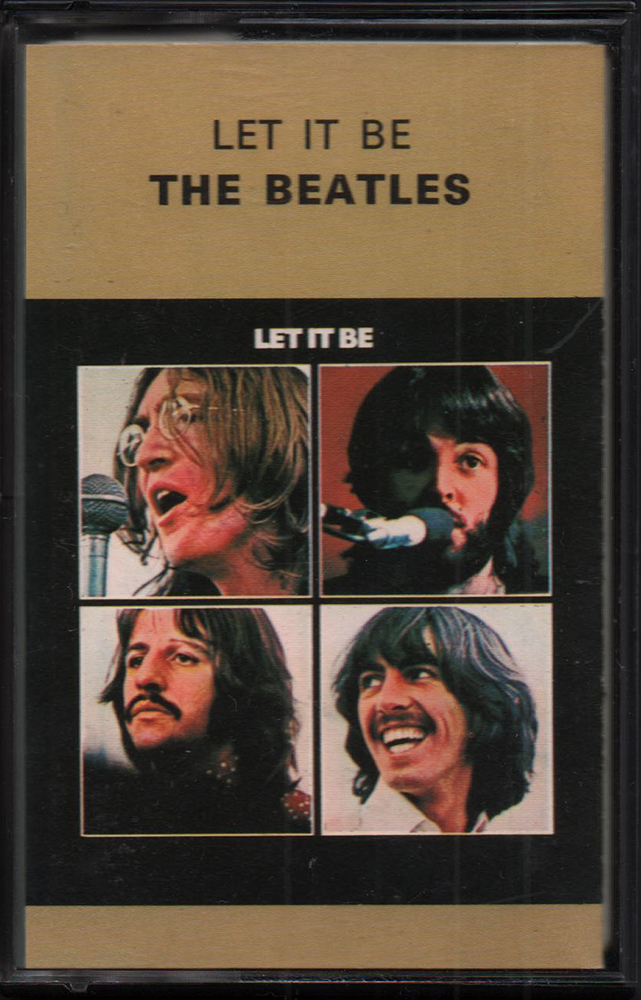 |
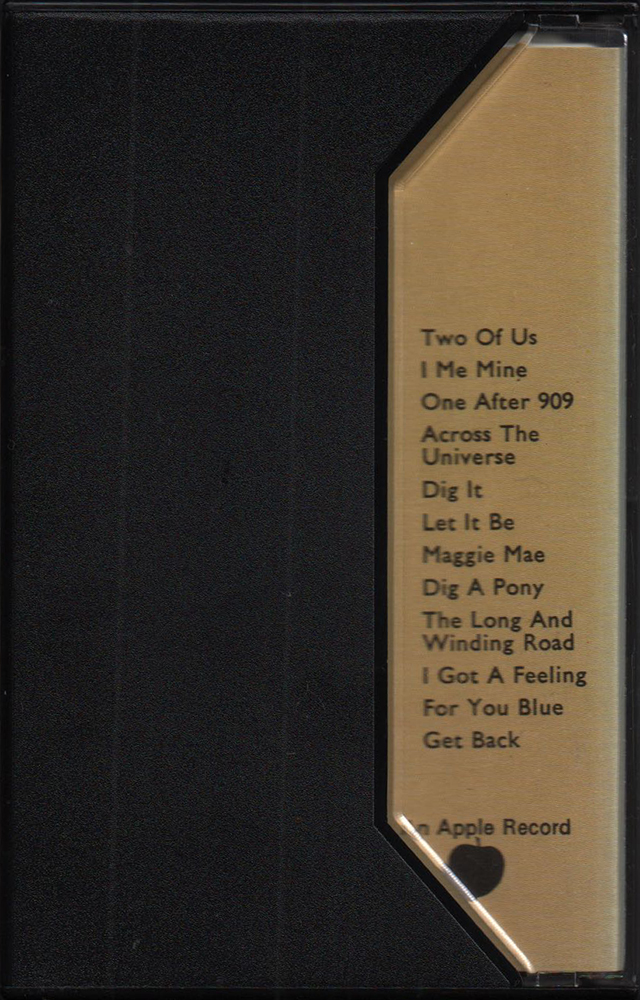 |
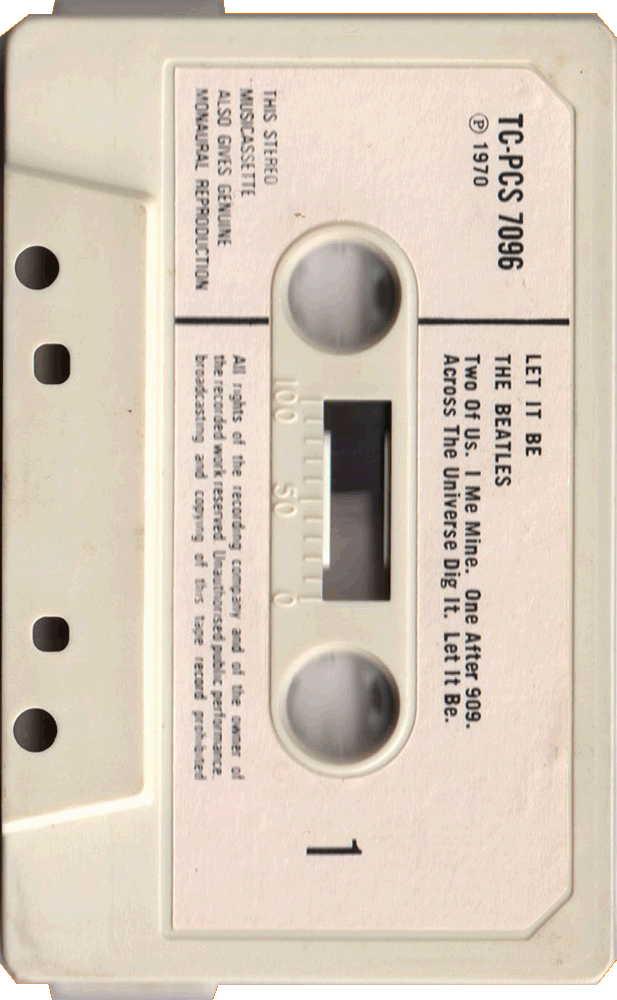 |
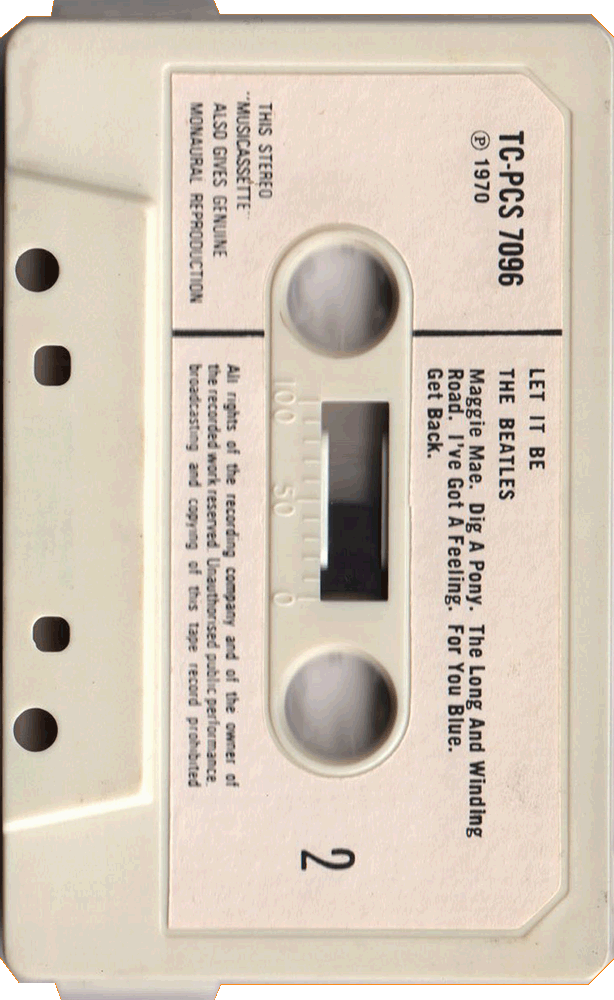 |
|
| The cassette cases ("Norelco" cases)
were clear plastic at the front and around the spine area,
and black plastic at the rear. |
This UK issue has White
paper label on white shell. |
|||
| INLAY |
INLAY: FRONT | INLAY: INSIDE |
||
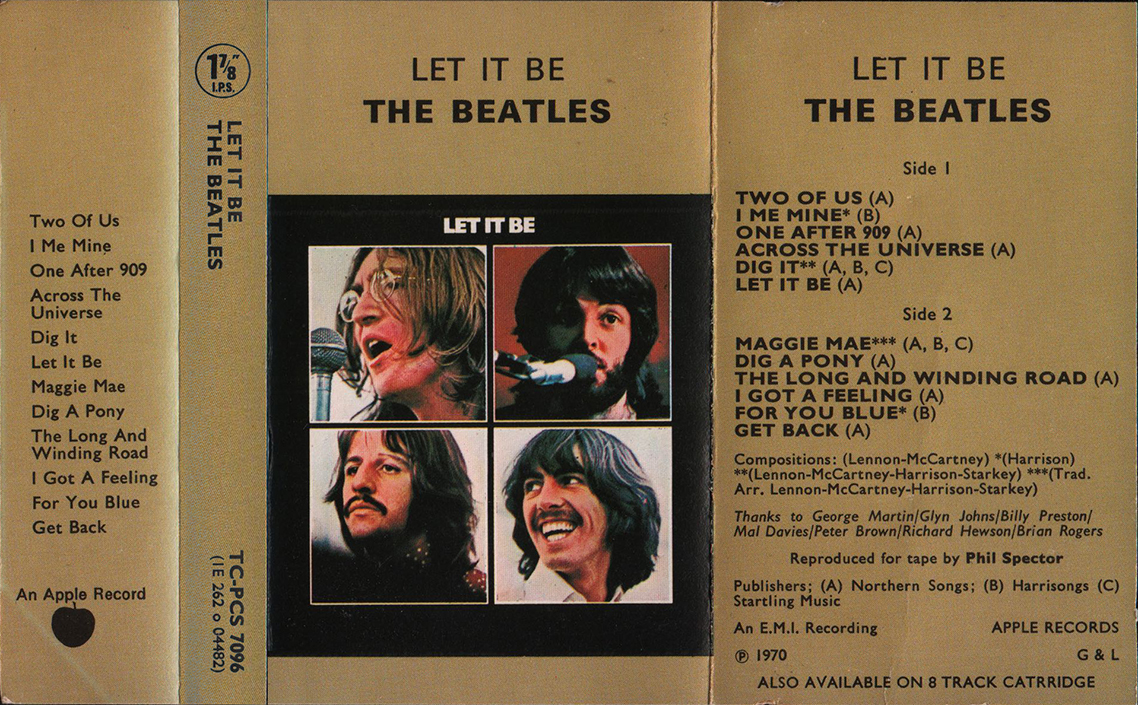 |
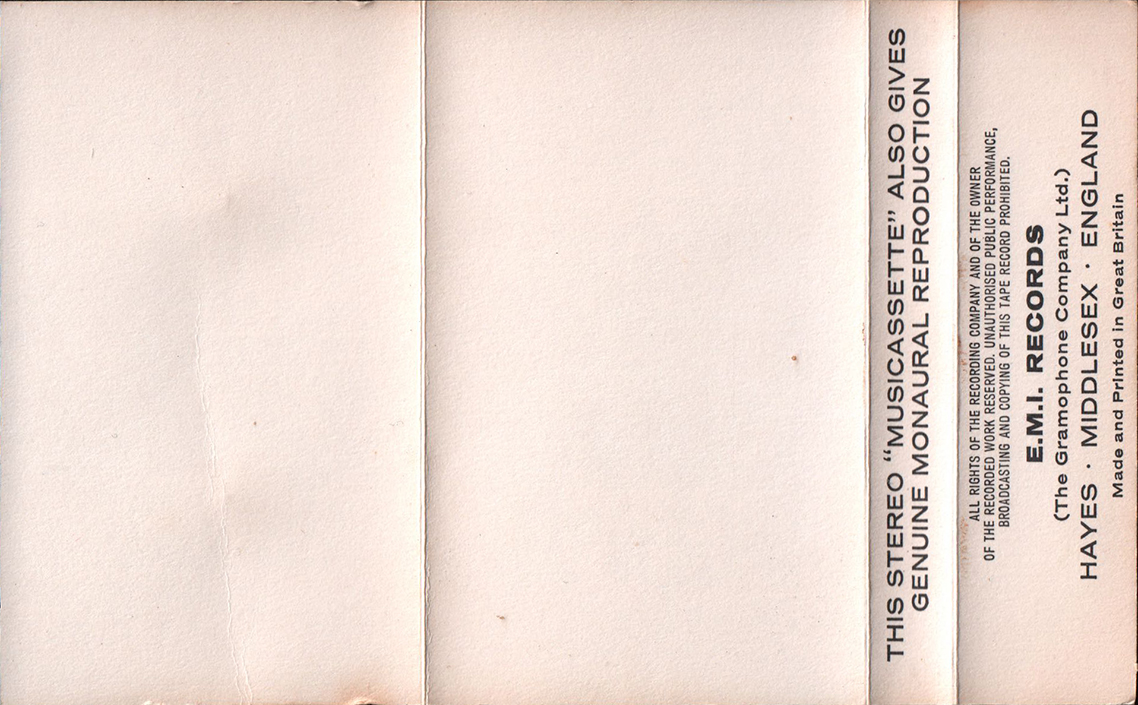 |
|||
| Changed the"Ochre" cassette inlay.
Does not have 'metallic' gold finish. ”Ochre inlay" have been introduced in 1976 (maybe). |
||||
| INLAY: FRONT CLOSE UP | ||||
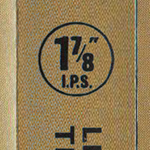 |
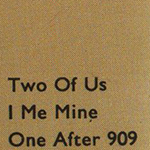 |
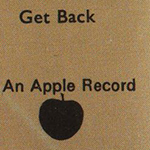 |
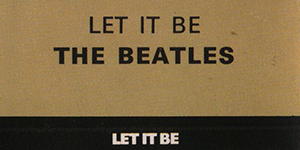 |
|
| The circular 1 7/8 " I.P.S. mark was printed at the spine. | Dolby logomark was not printed on the inlay. | Apple logomark was added on the inlay. | EMI Ochre cassette inlay. | |
| INLAY: FRONT CLOSE UP | ||||
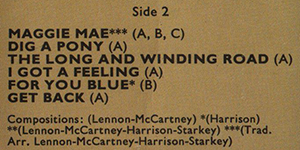 |
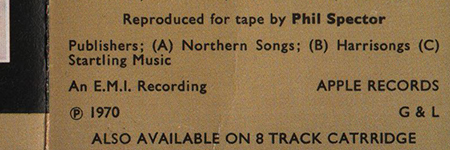 |
|||
| EMI originally issued the Beatles
UK albums on cassette tape with re-arranged running orders,
the excuse being the need to have two sides of equal length
to avoid the problem of listeners stopping the tape at the
end of one side and turning over to start mid-way through
the opening track on the reverse. Inlay incorrectly spells track 4 on side-2 as "I got a feeling" |
||||
| INLAY: INSIDE CLOSE UP | ||||
 |
Catalog number "TC-PCS 7096" and the EMI country code (*1) were printed on the inlay. |  |
Printer company's name (removed relrease date) "G&L" was printed at the bottom of the inlay. | |
| INLAY: INSIDE CLOSE UP | ||||
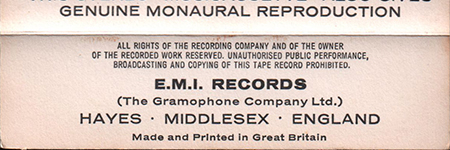 |
"E.M.I.
Records (The Gramophone Company Ltd.)" credit was printed at
the bottom of the inside of the inlay. |
|||
| LABEL CLOSE UP | ||||
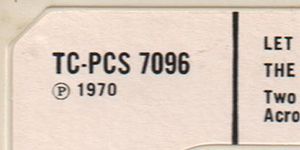 |
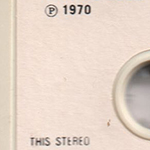 |
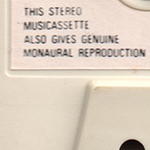 |
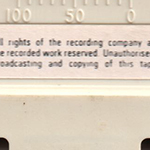 |
|
| The cassettes
was issued NO Parlophone logo. "IE" catalogue number (*) in addition to the ordinary "TC-PCS 7096" EMI catalogue number, but not printed on the label. |
Containing content as a prerecorded cassette is called "Musicassette" | NO mark was moulded into cassette shells. | ||
| LABEL CLOSE UP | ||||
| SIDE
1 |
SIDE 2 |
EMI
originally
issued
the Beatles UK albums on cassette tape with re-arranged
running orders. Bars in windows. |
||
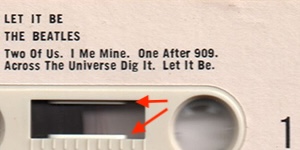 |
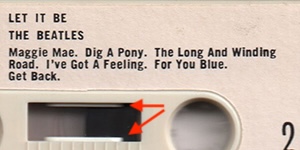 |
|||
| LABEL CLOSE UP | ||||
 |
"Made
in
England
/ Made in U.S.A" was not embossed the shell. |
|||
| OTHER ITEM | ||||
| - |
||||
| LABEL | White Paper Label without
Parlophone logo |
|||
| MIX | STEREO |
|||
| RECORD COMPANY'S NAME | EMI Records (The Gramophone Company Ltd.) / An E.M.I. Recording | |||
| CENTRAL REMARK "SOLD IN U.K." |
- | |||
| RECORDING PUBLISHED CREDIT | (P) 1970 |
|||
| INLAY FORM | "Ochre" inlay with Apple logo
(Foldover) |
|||
| SHELL | White Shell / bars in windows |
|||
| CASSETTE CASE |
"Norelco"
cases:
clear
plastic at the front and around the spine area, and black
plastic at the rear. |
|||
| PRINTER CREDIT | Made and Printed in Great Britain / G
& L (Garrod & Lofthouse) |
|||
| COVER DESIGN/ PHOTO/ NOTES | Design: by John Kosh Photographs: Ethan Russell |
|||
| PRODUCER | Reproduced for tape by Phil Spector | |||
| COMMENTS | White paper label without
Parlophone logo on white shell cassette, with its
original inlay and case. “Gold Top inlay” are believed to have been introduced in January 1972. Changed the "Ochre" cassette inlay. Does not have 'metallic' gold finish. ”Ochre inlay" have been introduced in 1976 (maybe). The G&L notation on the inside inlay indicates the printer's initials (Ernest J Day, Garrod & Lofthouse, or Data Packaging). The EMI UK catalog no. (TC-PCS-7096) was on the spine. The cassette cases ("Norelco" cases) were clear plastic at the front and around the spine area, and black plastic at the rear. (*1) EMI country code: 1E 262 o 04482 The EMI country codes (introduced on 1 June, 1969): In most cases the EMI Codes are the first two letters of the record's catalog#. These EMI Country Codes were used to indicate the country in which the record was pressed. Note this doesn't necessarily means the record was also released in that country (from Discog). OC / 0C / 1E= UK |
|||
|
TITLE
|
LET IT BE |
|||
| CATALOG NUMBER | TC-PCS 7096 / 1E 262 o 04482 |
|||
|
RELEASE DATE
|
1976? / 8th Issue? | |||
| TRACK LISTING | SIDE 1 | SIDE 2 | ||
| Two Of Us [A1] |
Maggie Mae [A7] |
|||
| I Me Mine [A4] |
Dig A Pony [A2] |
|||
| One After 909 [B2] |
The Long And Winding Road [B3] |
|||
| Across The Universe [A3] |
I Got A Feeling [B1] (inlay) |
|||
| Dig It [A5] |
For You Blue [B4] |
|||
| Let It Be [A6] | Get Back [B5] | |||
| CASSETTE CASE AND TAPE |
CASE FRONT | CASE BACK | SIDE 1 --> Click! | SIDE 2 --> Click! |
 |
 |
 |
 |
|
| The cassette cases ("Norelco" cases)
were clear plastic at the front and around the spine area,
and black plastic at the rear. |
This UK issue has White
paper
label on light grey shell. |
|||
| INLAY |
INLAY: FRONT | INLAY: INSIDE |
||
 |
 |
|||
| Changed the"Ochre" cassette inlay. Does
not have 'metallic' gold finish. ”Ochre inlay" have been introduced in 1976 (maybe). |
||||
| INLAY: FRONT CLOSE UP | ||||
 |
 |
 |
 |
|
| The circular 1 7/8 " I.P.S. mark was printed at the spine. | Dolby logomark
was added on the inlay. |
Apple logomark was added on the inlay. | EMI Ochre cassette inlay. | |
| INLAY: FRONT CLOSE UP | ||||
 |
 |
|||
| EMI originally issued the Beatles
UK albums on cassette tape with re-arranged running orders,
the excuse being the need to have two sides of equal length
to avoid the problem of listeners stopping the tape at the
end of one side and turning over to start mid-way through
the opening track on the reverse. Inlay incorrectly spells track 4 on side-2 as "I got a feeling" |
||||
| INLAY: INSIDE CLOSE UP | ||||
 |
Dolby logo, catalog number "TC-PCS 7096" and the EMI country code (*1) were printed on the inlay. |  |
Printer company's name (removed relrease date) "G&L" was printed at the bottom of the inlay. | |
| INLAY: INSIDE CLOSE UP | ||||
 |
It has been recorded with the "DOLBY SYSTEM (B-type)" noise reduction characteristic. | |||
 |
"EMI
Records Ltd Hayes Middlesex England"
credit and "Made and Printed in Great Britain" were printed
at the bottom of the inside of the inlay. |
|||
| LABEL CLOSE UP | ||||
 |
 |
 |
 |
|
| The cassettes
was issued Apple logo in blue ink. "IE" catalogue number (*) in addition to the ordinary "TC-PCS 7096" EMI catalogue number, but not printed on the label. |
"Dolby System" logo
was added on the label. |
NO mark was moulded into cassette shells. | ||
| LABEL CLOSE UP | ||||
 |
 |
EMI originally
issued the Beatles UK albums on cassette tape with
re-arranged running orders, the reason for this was that
because of the 8-track stereo tapes made at the same time,
it was necessary to adjust the endless tape's four tracks to
be approximately the same length. |
||
 |
 |
|||
| LABEL CLOSE UP | ||||
 |
"Made
in
England / Made in U.S.A" was not embossed the shell. |
|||
| OTHER ITEM | ||||
| - |
||||
| LABEL | White Paper Label with Apple
logo in blue ink |
|||
| MIX | STEREO |
|||
| RECORD COMPANY'S NAME | EMI Records Ltd. / An E.M.I.
Recording / Apple Records |
|||
| CENTRAL REMARK "SOLD IN U.K." |
- | |||
| RECORDING PUBLISHED CREDIT | (P) 1970 |
|||
| INLAY FORM | "Ochre" inlay (Foldover) with Apple
and Dolby logo |
|||
| SHELL | Light Grey Shell |
|||
| CASSETTE CASE |
"Norelco"
cases:
clear plastic at the front and around the spine area, and
black plastic at the rear. |
|||
| PRINTER CREDIT | Made and Printed in Great Britain / G
& L (Garrod & Lofthouse) |
|||
| COVER DESIGN/ PHOTO/ NOTES | Design: by John Kosh Photographs: Ethan Russell |
|||
| PRODUCER | Reproduced for tape by Phil Spector | |||
| COMMENTS | White paper label with Apple
logo in blue ink on light grey shell cassette, with
its original inlay and case. “Gold Top inlay” are believed to have been introduced in January 1972. Changed the "Ochre" cassette inlay. Does not have 'metallic' gold finish. ”Ochre inlay" have been introduced in 1976 (maybe). The G&L notation on the inside inlay indicates the printer's initials (Ernest J Day, Garrod & Lofthouse, or Data Packaging). The EMI UK catalog no. (TC-PCS-7096) was on the spine. The cassette cases ("Norelco" cases) were clear plastic at the front and around the spine area, and black plastic at the rear. It has been recorded with the "DOLBY SYSTEM (B-type)" noise reduction characteristic. A Dolby noise-reduction system, or Dolby NR, is one of a series of noise reduction systems developed by Dolby Laboratories for use in analog audio tape recording. The first was Dolby A, a professional broadband noise reduction system for recording studios in 1965, but the best-known is Dolby B (introduced in 1968) for the consumer market, which helped make high fidelity practical on cassette tapes, which used a relatively noisy tape size and speed. From the mid-1970s, Dolby B became standard on commercially pre-recorded music cassettes. (*1) EMI country code: 1E 262 o 04482 The EMI country codes (introduced on 1 June, 1969): In most cases the EMI Codes are the first two letters of the record's catalog#. These EMI Country Codes were used to indicate the country in which the record was pressed. Note this doesn't necessarily means the record was also released in that country (from Discog). OC / 0C / 1E= UK |
|||
|
TITLE
|
LET IT BE |
|||
| CATALOG NUMBER | TC-PCS 7096 / 1E 262 o 04482 |
|||
|
RELEASE DATE
|
1977? / 9th Issue? | |||
| TRACK LISTING | SIDE 1 | SIDE 2 | ||
| Two Of Us [A1] |
Maggie Mae [A7] |
|||
| I Me Mine [A4] |
Dig A Pony [A2] |
|||
| One After 909 [B2] |
The Long And Winding Road [B3] |
|||
| Across The Universe [A3] |
I Got A Feeling [B1] (inlay) |
|||
| Dig It [A5] |
For You Blue [B4] |
|||
| Let It Be [A6] | Get Back [B5] | |||
| CASSETTE CASE AND TAPE |
CASE FRONT | CASE BACK | SIDE 1 --> Click! | SIDE 2 --> Click! |
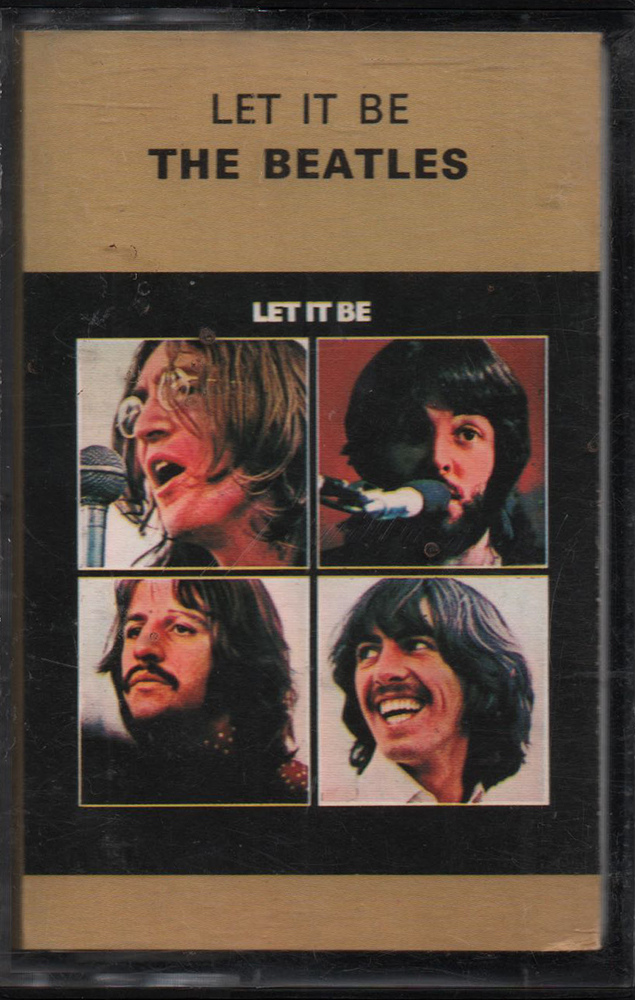 |
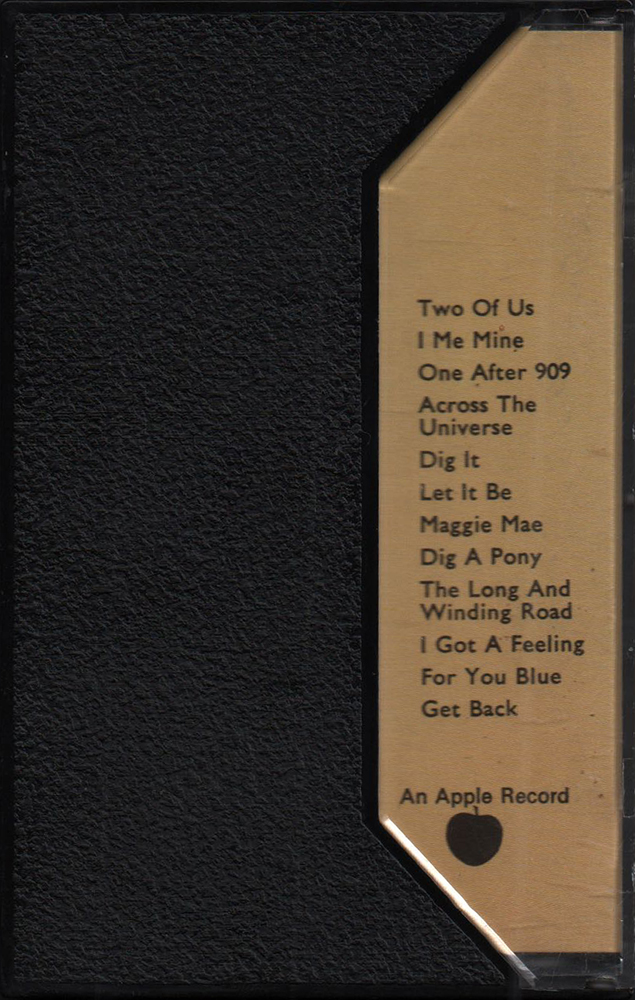 |
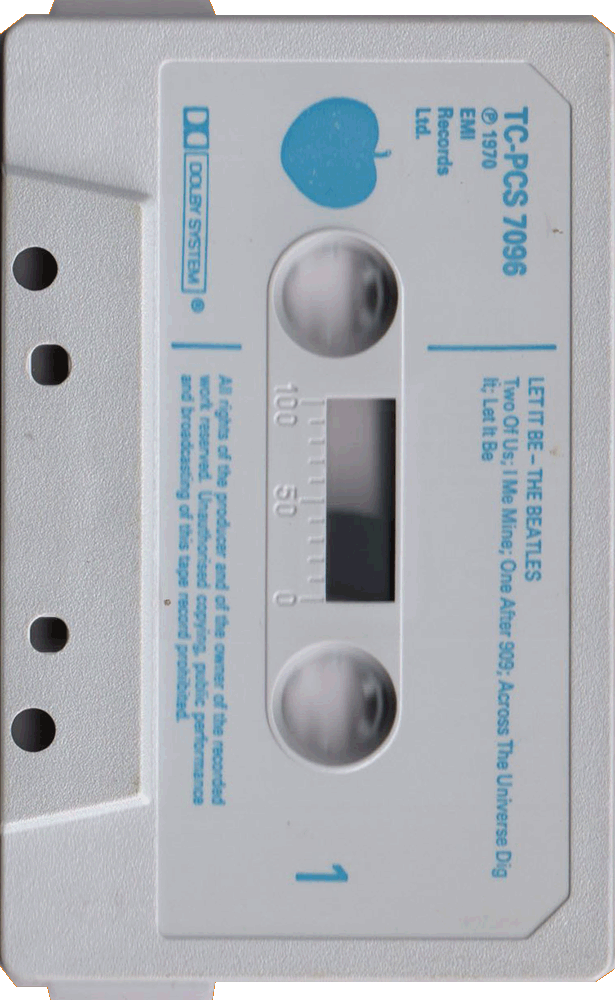 |
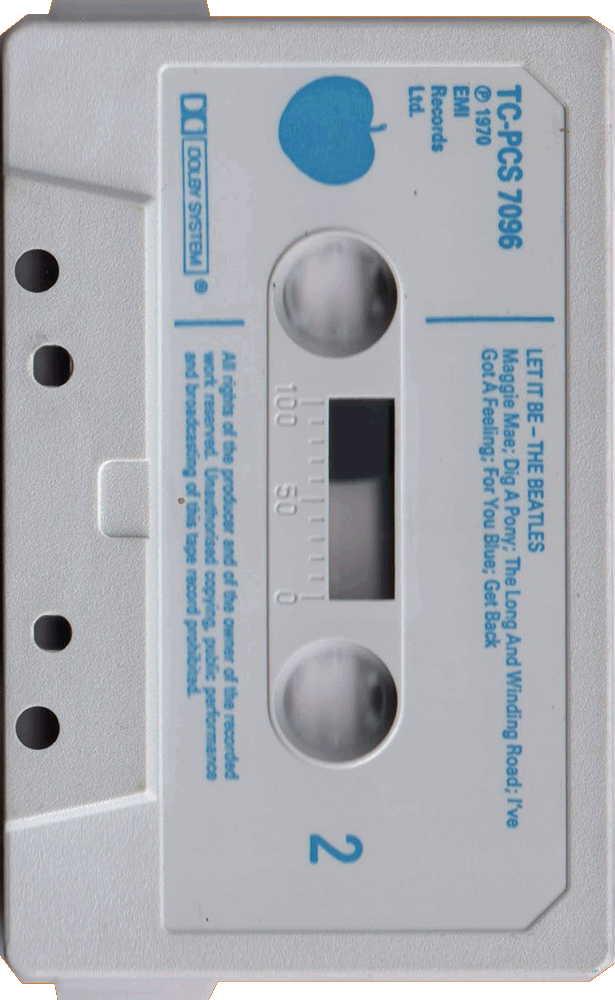 |
|
| The cassette cases ("Norelco" cases)
were clear plastic at the front and around the spine area,
and black plastic at the rear. |
Has direct print in blue ink on the light
grey shell. |
|||
| INLAY |
INLAY: FRONT | INLAY: INSIDE |
||
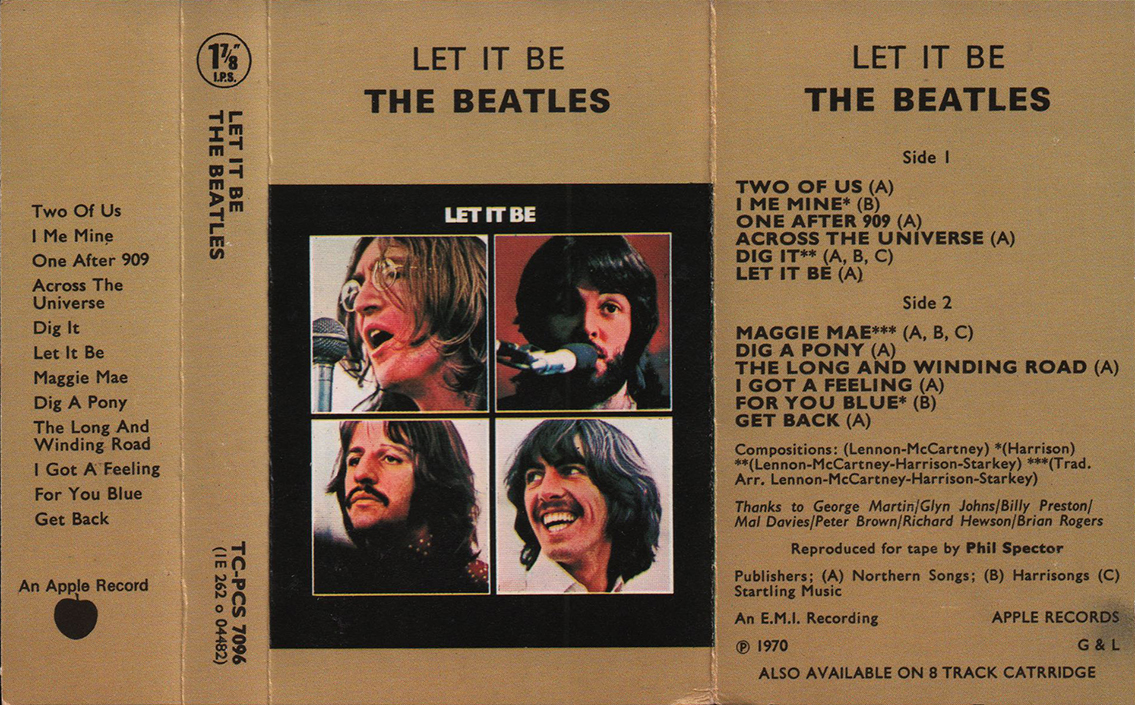 |
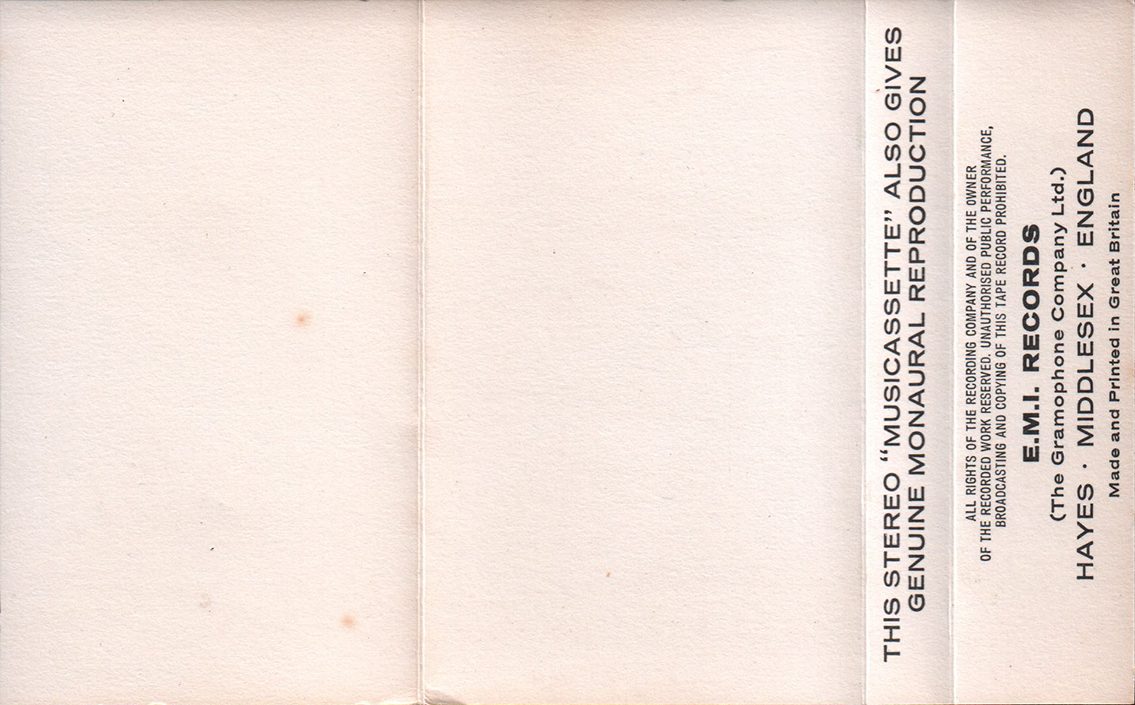 |
|||
| Changed the"Ochre" cassette inlay.
Does not have 'metallic' gold finish. ”Ochre inlay" have been introduced in 1976 (maybe). |
||||
| INLAY: FRONT CLOSE UP | ||||
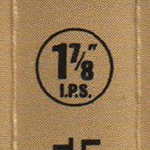 |
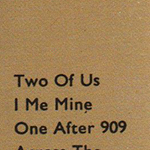 |
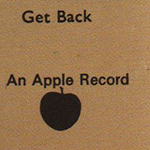 |
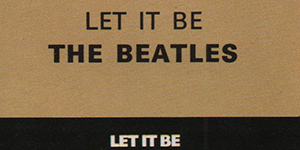 |
|
| The circular 1 7/8 " I.P.S. mark was printed at the spine. | Dolby logomark
was NOT printed on the inlay. |
Apple logomark was added on the inlay. | EMI Ochre cassette inlay. | |
| INLAY: FRONT CLOSE UP | ||||
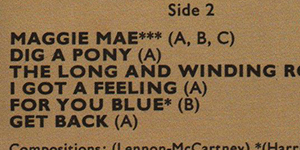 |
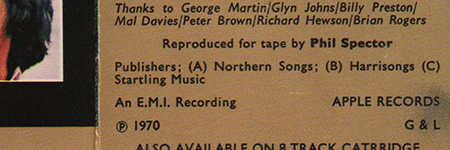 |
|||
| EMI released Beatles cassettes
with a different running order. This was because the 8-track tapes made at the same time needed all four tracks to be about the same length. Inlay incorrectly spells track 4 on side-2 as "I got a feeling" |
||||
| INLAY: INSIDE CLOSE UP | ||||
 |
Catalog number "TC-PCS 7096" and the EMI country code (*1) were printed on the inlay. |  |
Printer company's name "G&L" was printed at the bottom of the inlay. | |
| INLAY: INSIDE CLOSE UP | ||||
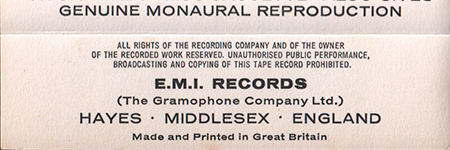 |
"E.M.I.
Records (The Gramophone Company Ltd.)" credit was printed at
the bottom of the inside of the inlay. |
|||
| LABEL CLOSE UP | ||||
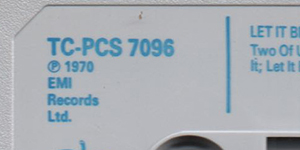 |
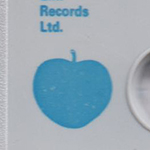 |
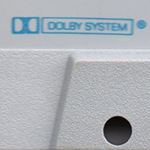 |
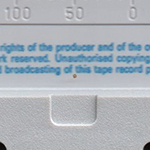 |
|
| The cassettes
was issued Apple logo in blue ink. "IE" catalogue number (*) in addition to the ordinary "TC-PCS 7096" EMI catalogue number, but not printed on the label. |
"Dolby System" logo
was added on the label. |
Notch in Head of one side of Cassette. | ||
| LABEL CLOSE UP | ||||
| SIDE 1 |
SIDE 2 |
EMI released Beatles
cassettes with a different running order. This was because the 8-track tapes made at the same time needed all four tracks to be about the same length. |
||
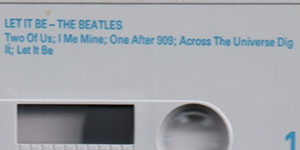 |
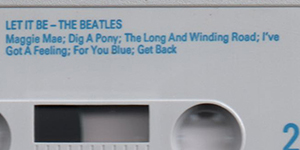 |
|||
| LABEL CLOSE UP | ||||
 |
"Made
in
England
/
Made in U.S.A" was not embossed the shell. |
|||
| OTHER ITEM | ||||
| - |
||||
| LABEL | Direct print in blue ink on the shell with
Apple logo / with Light grey shell |
|||
| MIX | STEREO |
|||
| RECORD COMPANY'S NAME | EMI Records (The Gramophone Company Ltd.)
/ An E.M.I. Recording / Apple Records |
|||
| CENTRAL REMARK "SOLD IN U.K." |
- | |||
| RECORDING PUBLISHED CREDIT | (P) 1970 |
|||
| INLAY FORM | "Ochre" inlay with Apple logo
(Foldover) |
|||
| SHELL | Light Grey Shell |
|||
| CASSETTE CASE |
"Norelco"
cases:
clear
plastic
at the front and around the spine area, and black plastic at
the rear. |
|||
| PRINTER CREDIT | Made and Printed in Great Britain / G
& L (Garrod & Lofthouse) |
|||
| COVER DESIGN/ PHOTO/ NOTES | Design: by John Kosh Photographs: Ethan Russell |
|||
| PRODUCER | Reproduced for tape by Phil Spector | |||
| COMMENTS | Direct print in blue ink label
with Apple logo cassette. It has a grey tape shell with blue on-body text which suggests a manufacturing date of 1976 onwards. “Gold Top inlay” are believed to have been introduced in January 1972. Changed the "Ochre" cassette inlay. Does not have 'metallic' gold finish. ”Ochre inlay" have been introduced in 1976 (maybe). The G&L notation on the inside inlay indicates the printer's initials (Ernest J Day, Garrod & Lofthouse, or Data Packaging). The EMI UK catalog no. (TC-PCS-7096) was on the spine. The cassette cases ("Norelco" cases) were clear plastic at the front and around the spine area, and black plastic at the rear. It has been recorded with the "DOLBY SYSTEM (B-type)" noise reduction characteristic. A Dolby noise-reduction system, or Dolby NR, is one of a series of noise reduction systems developed by Dolby Laboratories for use in analog audio tape recording. The first was Dolby A, a professional broadband noise reduction system for recording studios in 1965, but the best-known is Dolby B (introduced in 1968) for the consumer market, which helped make high fidelity practical on cassette tapes, which used a relatively noisy tape size and speed. From the mid-1970s, Dolby B became standard on commercially pre-recorded music cassettes. (*1) EMI country code: 1E 262 o 04482 The EMI country codes (introduced on 1 June, 1969): In most cases the EMI Codes are the first two letters of the record's catalog#. These EMI Country Codes were used to indicate the country in which the record was pressed. Note this doesn't necessarily means the record was also released in that country (from Discog). OC / 0C / 1E= UK |
|||
|
TITLE
|
LET IT BE |
|||
| CATALOG NUMBER | TC-PCS 7096 / 1E 262 o 04482 |
|||
|
RELEASE DATE
|
1983? / 10th Issue? | |||
| TRACK LISTING | SIDE 1 | SIDE 2 | ||
| Two Of Us [A1] |
Maggie Mae [A7] |
|||
| I Me Mine [A4] |
Dig A Pony [A2] |
|||
| One After 909 [B2] |
The Long And Winding Road [B3] |
|||
| Across The Universe [A3] |
I Got A Feeling [B1] (inlay) |
|||
| Dig It [A5] |
For You Blue [B4] |
|||
| Let It Be [A6] | Get Back [B5] | |||
| CASSETTE CASE AND TAPE |
CASE FRONT | CASE BACK | SIDE 1 --> Click! | SIDE 2 --> Click! |
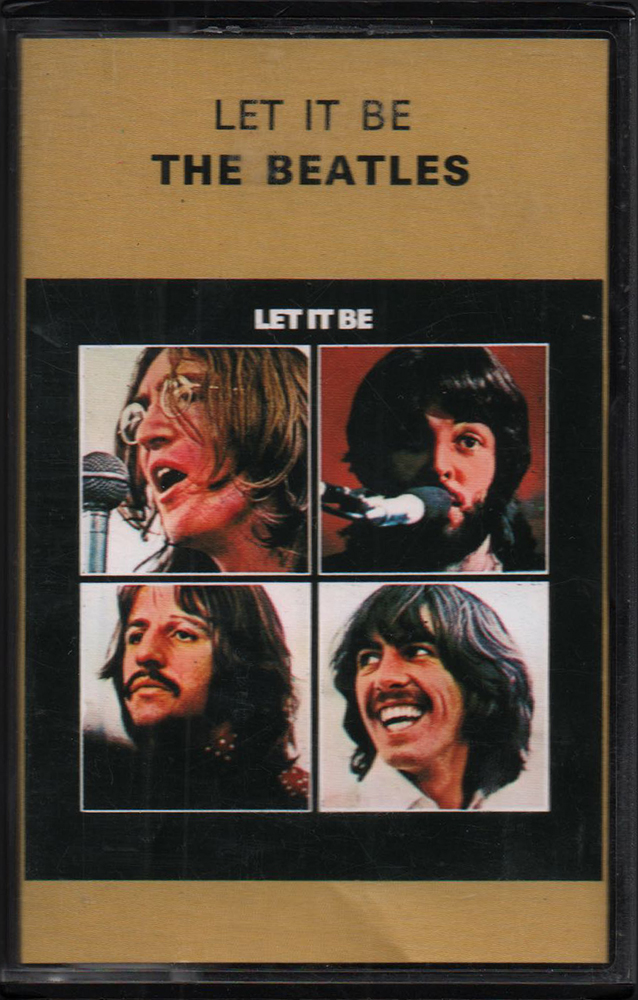 |
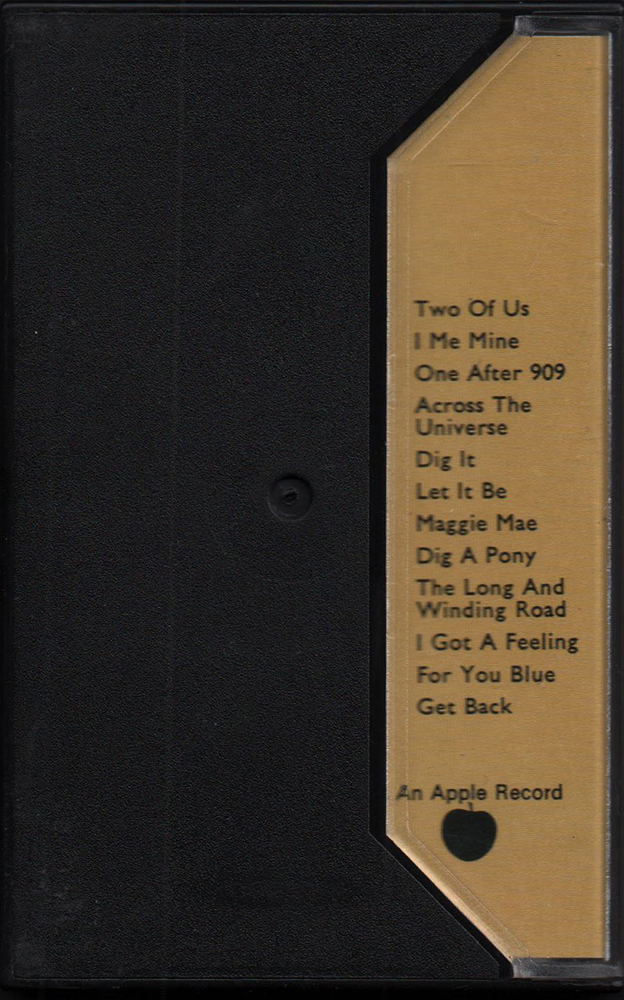 |
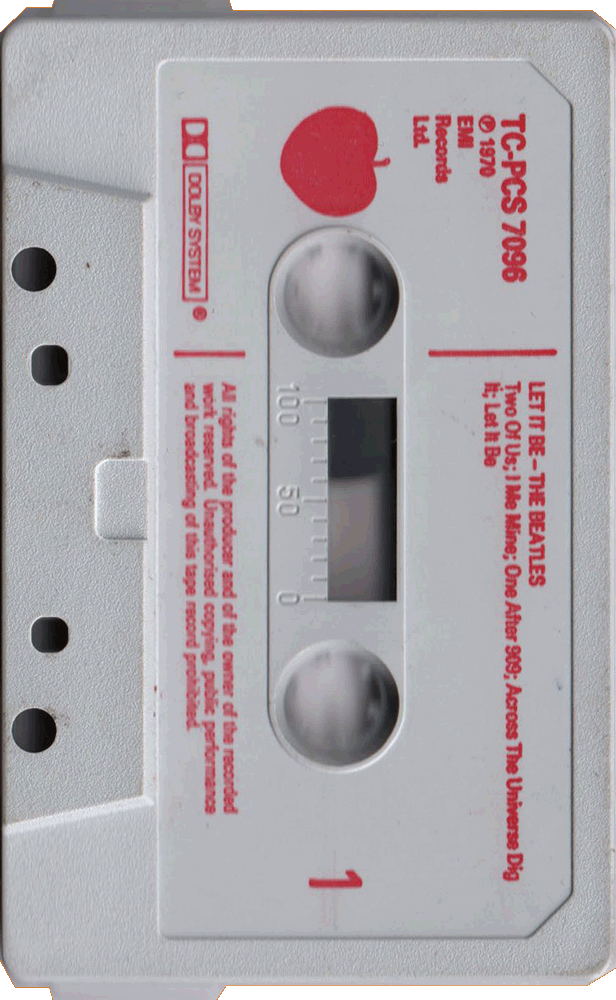 |
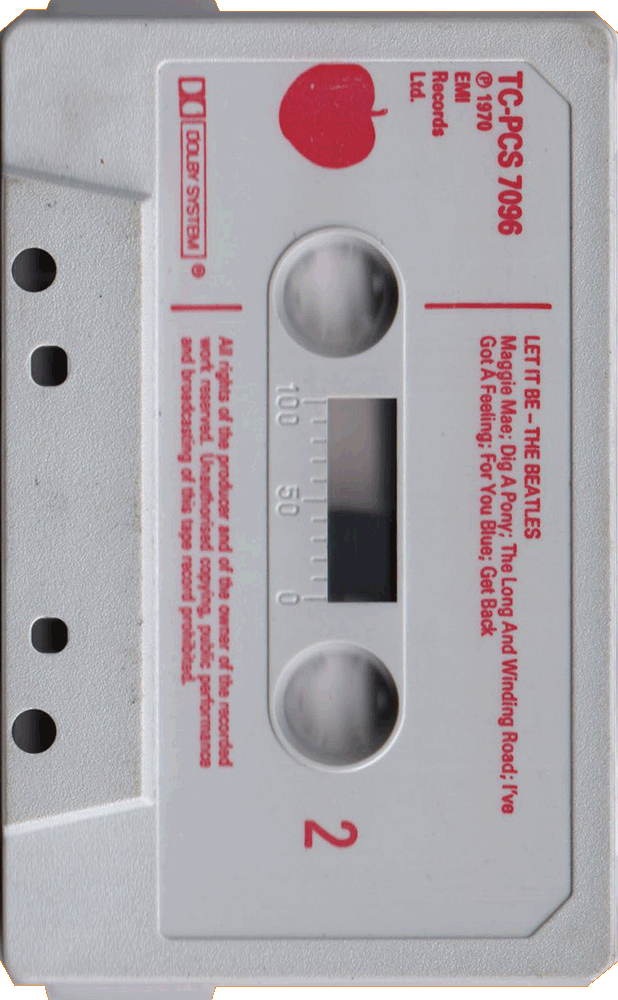 |
|
| The cassette cases ("Norelco" cases)
were clear plastic at the front and around the spine area,
and black plastic at the rear. |
Has direct print in red ink on the light
grey shell. |
|||
| INLAY |
INLAY: FRONT | INLAY: INSIDE |
||
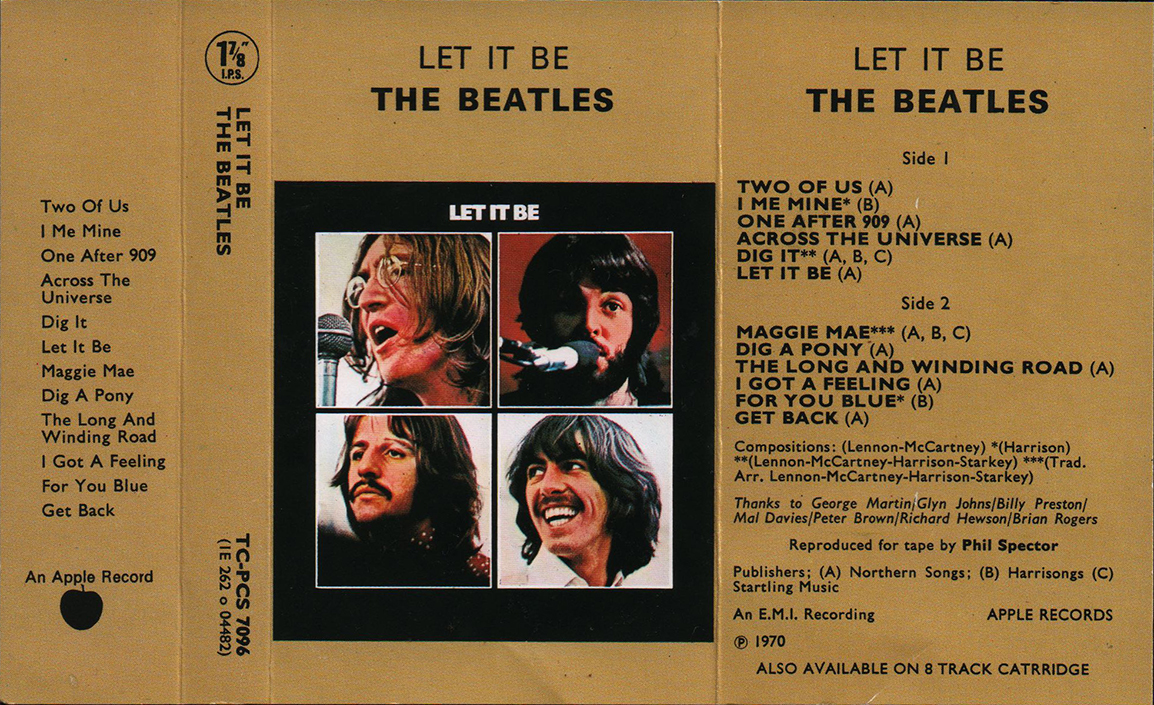 |
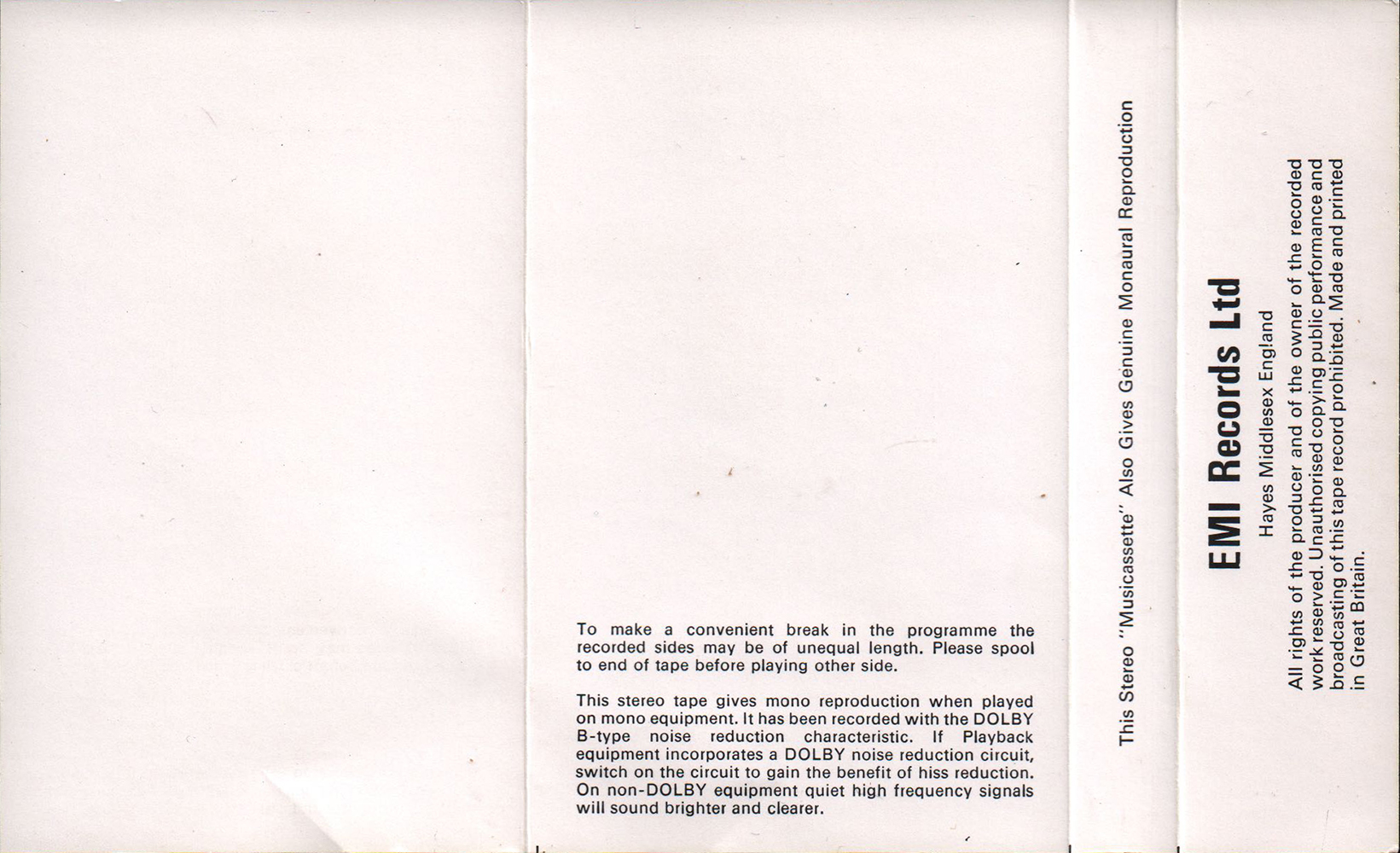 |
|||
| Changed the"Ochre" cassette inlay.
Does not have 'metallic' gold finish. ”Ochre inlay" have been introduced in 1976 (maybe). |
||||
| INLAY: FRONT CLOSE UP | ||||
 |
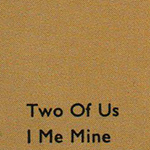 |
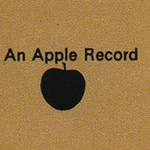 |
 |
|
| The circular 1 7/8 " I.P.S. mark was printed at the spine. | Dolby logomark
was NOT printed on the inlay. |
Apple logomark was added on the inlay. | EMI Ochre cassette inlay. | |
| INLAY: FRONT CLOSE UP | ||||
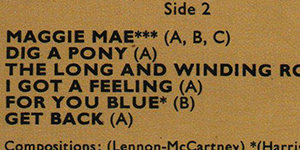 |
 |
|||
| EMI released Beatles cassettes
with a different running order. This was because the 8-track tapes made at the same time needed all four tracks to be about the same length. Inlay incorrectly spells track 4 on side-2 as "I got a feeling" |
||||
| INLAY: INSIDE CLOSE UP | ||||
 |
Catalog number "TC-PCS 7096" and the EMI country code (*1) were printed on the inlay. |  |
Printer company's name "G&L" was removed at the bottom of the inlay. | |
| INLAY: INSIDE CLOSE UP | ||||
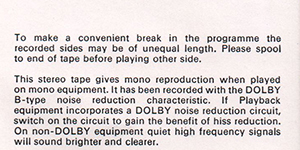 |
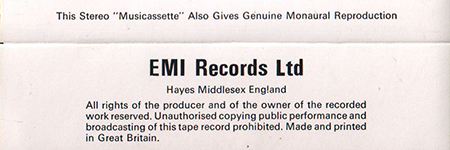 |
|||
| The phrase "It
has been recorded with the DOLBY B-type noise
reduction characteristic" was printed on the inlay. |
"EMI Records
Ltd Hayes Middlesex England" credit and "Made
and Printed in Great Britain" were printed at the bottom of
the inside of the inlay. |
|||
| LABEL CLOSE UP | ||||
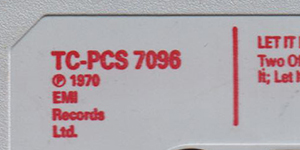 |
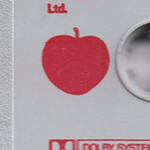 |
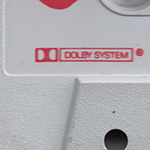 |
 |
|
| The cassettes
was issued Apple logo in red ink. "IE" catalogue number (*) in addition to the ordinary "TC-PCS 7096" EMI catalogue number, but not printed on the label. |
"Dolby System" logo
was added on the label. |
Notch in Head of one side of Cassette. | ||
| LABEL CLOSE UP | ||||
| SIDE 1 |
SIDE 2 |
EMI released Beatles
cassettes with a different running order. This was because the 8-track tapes made at the same time needed all four tracks to be about the same length. |
||
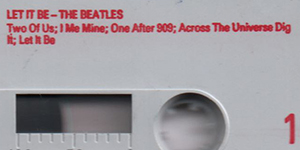 |
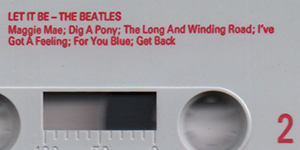 |
|||
| LABEL CLOSE UP | ||||
 |
"Made
in
England
/ Made in U.S.A" was not embossed the shell. |
|||
| OTHER ITEM | ||||
| - |
||||
| LABEL | Direct print in red ink on the
shell with Apple logo / with Light grey shell |
|||
| MIX | STEREO |
|||
| RECORD COMPANY'S NAME | EMI Records (The Gramophone Company Ltd.)
/ An E.M.I. Recording / Apple Records |
|||
| CENTRAL REMARK "SOLD IN U.K." |
- | |||
| RECORDING PUBLISHED CREDIT | (P) 1970 |
|||
| INLAY FORM | "Ochre" inlay with Apple logo
(Foldover) |
|||
| SHELL | Light Grey Shell |
|||
| CASSETTE CASE |
"Norelco"
cases:
clear
plastic at the front and around the spine area, and black
plastic at the rear. |
|||
| PRINTER CREDIT | Made and Printed in Great Britain / G & L (Garrod & Lofthouse) removed | |||
| COVER DESIGN/ PHOTO/ NOTES | Design: by John Kosh Photographs: Ethan Russell |
|||
| PRODUCER | Reproduced for tape by Phil Spector | |||
| COMMENTS | Direct print in red ink label
with Apple logo cassette. It has a grey tape shell with blue on-body text which suggests a manufacturing date of 1976 onwards. “Gold Top inlay” are believed to have been introduced in January 1972. Changed the "Ochre" cassette inlay. Does not have 'metallic' gold finish. ”Ochre inlay" have been introduced in 1976 (maybe). Printer company's name "G&L" was removed at the bottom of the inlay. The EMI UK catalog no. (TC-PCS-7096) was on the spine. The cassette cases ("Norelco" cases) were clear plastic at the front and around the spine area, and black plastic at the rear. It has been recorded with the "DOLBY SYSTEM (B-type)" noise reduction characteristic. A Dolby noise-reduction system, or Dolby NR, is one of a series of noise reduction systems developed by Dolby Laboratories for use in analog audio tape recording. The first was Dolby A, a professional broadband noise reduction system for recording studios in 1965, but the best-known is Dolby B (introduced in 1968) for the consumer market, which helped make high fidelity practical on cassette tapes, which used a relatively noisy tape size and speed. From the mid-1970s, Dolby B became standard on commercially pre-recorded music cassettes. (*1) EMI country code: 1E 262 o 04482 The EMI country codes (introduced on 1 June, 1969): In most cases the EMI Codes are the first two letters of the record's catalog#. These EMI Country Codes were used to indicate the country in which the record was pressed. Note this doesn't necessarily means the record was also released in that country (from Discog). OC / 0C / 1E= UK |
|||